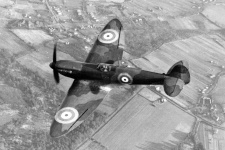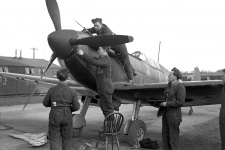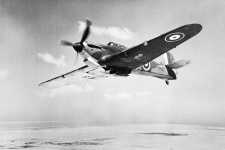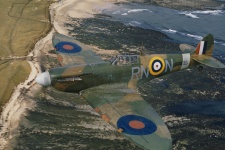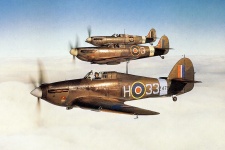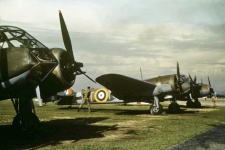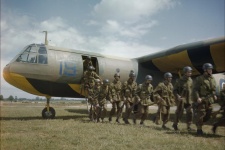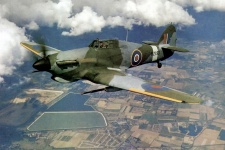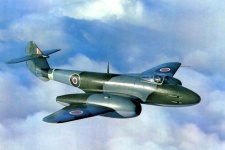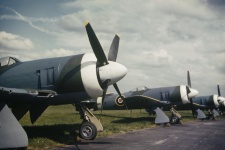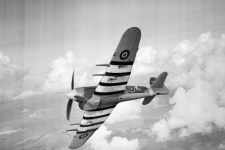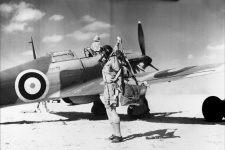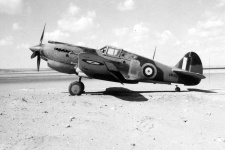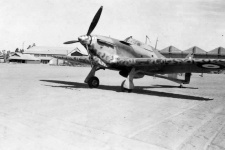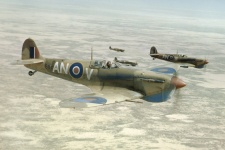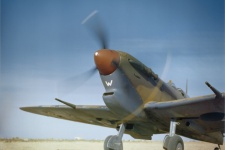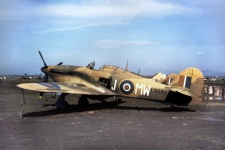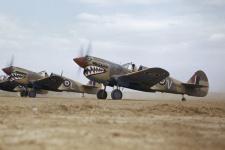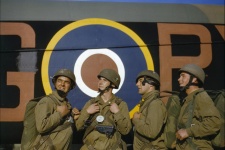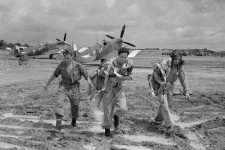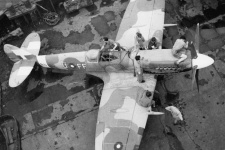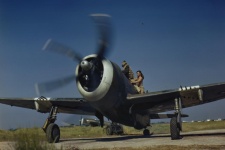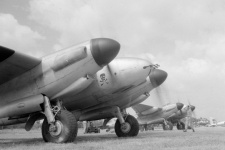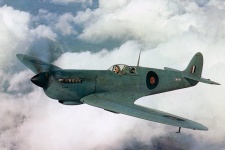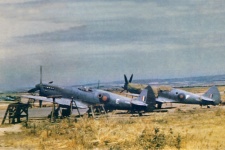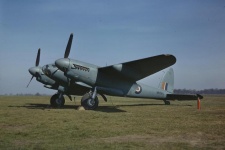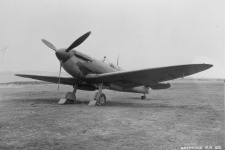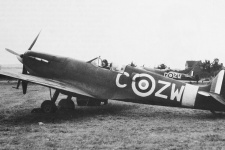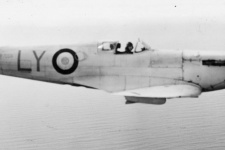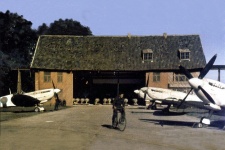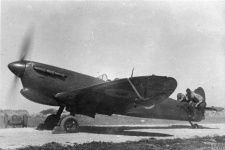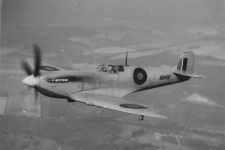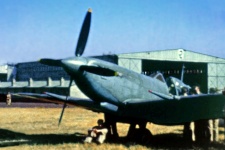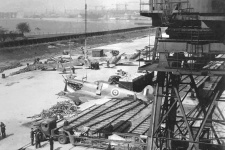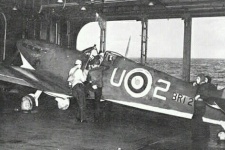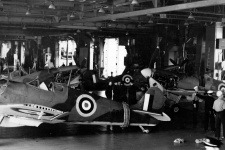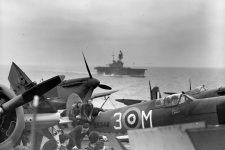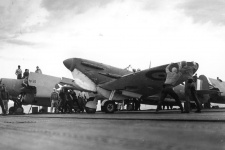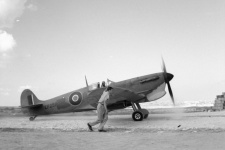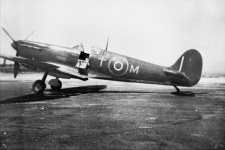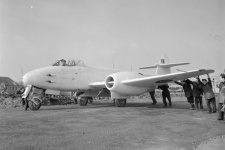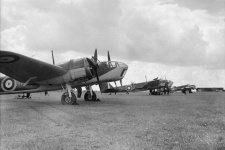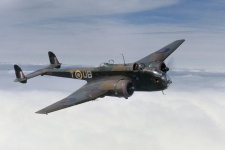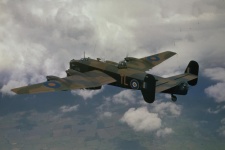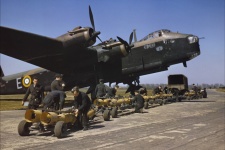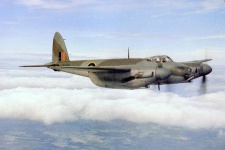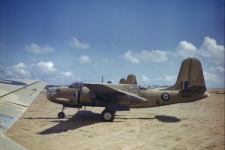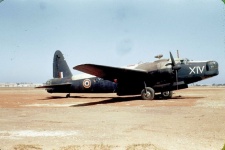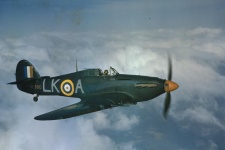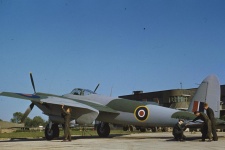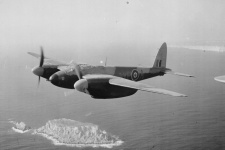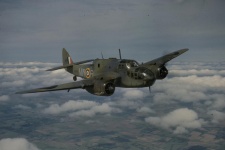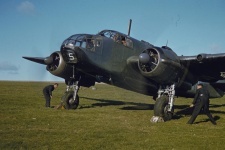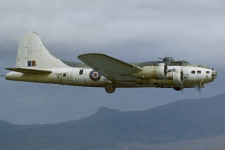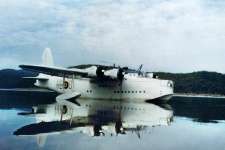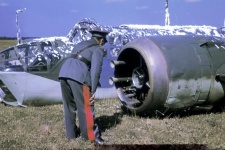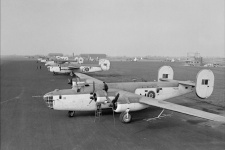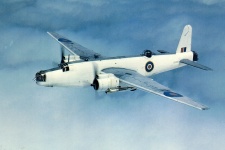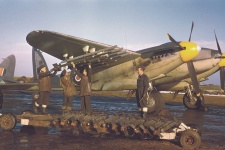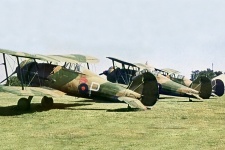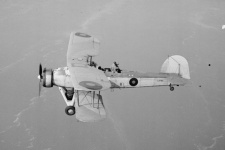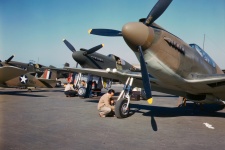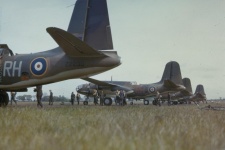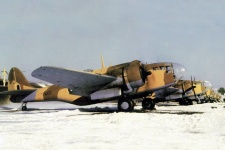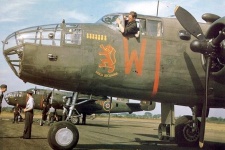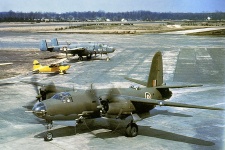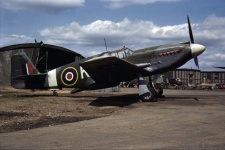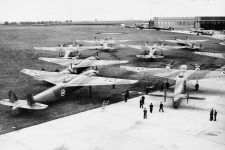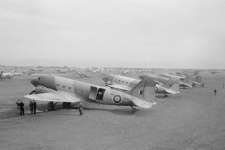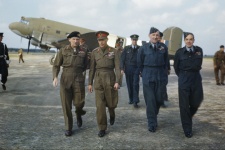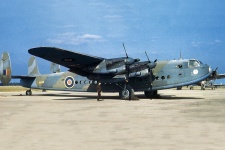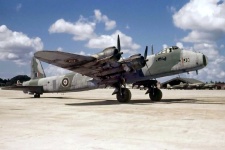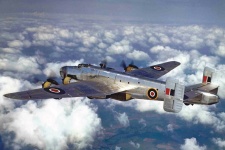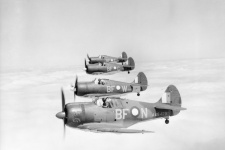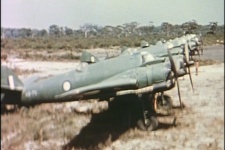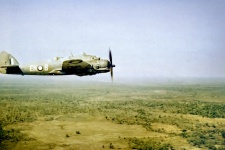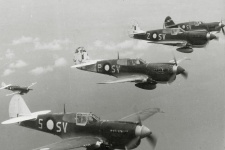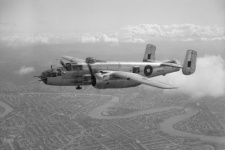Aircraft Colors and Camouflage, Royal Air Force (World War II)
![]()
Introduction to British color standards
The main color standard used on British military aircraft is known as British Standard BS 381, which was was introduced in 1930 as British Standard BS 381: Colours for Ready Mixed Paints. It was revised shortly thereafter in 1931 as British Standard BS 381C. This included a total of 57 colors known by their one or two-digit numbers and which were ordered in the following manner: blues, browns, greens, grays, reds, browns, and yellows. Neither white nor black were included. A further seven colors were later added bringing the total palette to 64 colors by the start of World War II. A few numbers were skipped, resulting in the numbering running from 1 to 73 with six of the seven newer colors not following the standard color order.
Numerous new colors were developed in the years before World War II while others were introduced after the war had started. From 1940, the Ministry of Aircraft Production (MAP) took charge of wartime color standards and this included all the major colors used on Royal Air Force (RAF) and Fleet Air Arm (FAA) aircraft. There were also two wartime updates of BS 381C (1943 and 1944) with a reduced palette of only 27 colors. However, only a handful of BS 381C colors were ever used for aircraft camouflage purposes. MAP colors did not have any numerical designation and were simply known by their names. Camouflage schemes were specified through numerous Air Ministry or Admiralty orders and were usually based around named two-tone disruptive schemes (such as the Temperate Sea Scheme) plus an underside color, and determined by aircraft role. US aircraft provided to the RAF/FAA via Lend-Lease were typically factory-painted in DuPont colors that closely approximated their MAP originals, and later in substitute paints from the ANA system.
Many of the wartime colors were subsequently incorporated into BS 381C in its first post-war updates in 1948 and 1964 (now known as BS 381C: Colours for Specific Purposes) though some were left out never to be used again, including some well-known ones like Ocean Grey. The 1948 update also adopted a three-digit numbering system where the first digit refereed to the color and last two two digits the shade. Color digits are: blue (1), green (2), yellow (3), brown (4), red (5), gray (6), and violet (7). Notably, no whites are included. Thankfully, almost all colors from the 1931 palette transfered their number to the last two digits so for example, No 1 Sky Blue became Sky Blue BS 101 and No 62 Middle Stone became Middle Stone BS 362. There were very few exceptions, such as No 43 Salmon Pink redesignated Salmon Pink BS 447 and some name changes like No 7 Dark Blue renamed Strong Blue BS 107. From the 1996 revision, all colors are specified as being semi-matt. A different standard, BS 4800: Paint Colours for Building Purposes has occasionally been used on aircraft as well with some colors like Barley Grey BS 18B21 eventually incorporated into BS 381C (as Camouflage Grey BS 626).
Contents:
- Tactical schemes
- Temperate Land Scheme (1938-40)
- Temperate Land Scheme (1940-41)
- Day Fighter Scheme (1941-45)
- Tropical Land Scheme (1940-41)
- Desert Scheme (1941-45)
- South-East Asia (1941-45)
- High-altitude PRU (1941-45)
- Low-altitude PRU (1941-45)
- High-altitude fighters (1941-45)
- Malta Spitfires (1942)
- White Meteors (1945)
- Strategic schemes Coastal schemes
- Other
External Links:
- BSC 381C Colour Chart (1931)
- British Standard BS 381C Colour Chart
- Other BS Colours
- Imperial War Museum Collections Online
- Aircraft of the R.A.F. and S.A.A.F. during World War II in Colour (Etienne du Plessis)
References:
- Tanner, John (ed.), British Aviation Colours of World War Two, Arms and Armour Press (1976)
Paint guide basics:
All colors in this page include a paint chart with matches or equivalences from 19 different model paint ranges. Paints are considered matches if they are labeled with the intended color (either uniquely on together with another color). Paints are considered equivalences if they are close to the intended color but not labeled as such. The accuracy of any paint is independent of whether it is a match or an equivalence and these are described in the text (there can be poor matches and highly accurate equivalences). The following nomenclature is used in the paint tables and is based on matches or equivalences to US Insignia Red FS 11136:
| Paint | Match or equivalence type (label) |
| MP01 | Labeled to match one specific color (FS 11136) |
| MP02* | Labeled to match more than one color of same-country standards (FS 11136 / ANA 509)* |
| MP03** | Labeled to match more than one color of different-country standards (FS 11136 / BS 538) |
| MP04 (!) | Questionable accuracy of label match (doesn't look like FS 11136) |
| MP05 (?) | Questionable accuracy of label match, untested (doesn't look like FS 11136 in the bottle) |
| (MP06) | Close equivalent to FS 11136 (BS 538) |
| (MP07) (?) | Questionable equivalent to FS 11136 (Generic Gloss Red) |
* A single asterisk also denotes implicit matches for same-country standards where there is an official succession between standards. For example, H327* would match ANA 509 even if the label only references FS 11136 since ANA 509 is its official predecessor. This does not apply when there are considerable differences between successive paints (ex: Olive Drab No. 41/ANA 613/FS 34087) and this will be described in the text. By and large, however, single asterisk matches should be considered close enough to unique matches as to not be seriously questioned.
The paint charts make no distinction between gloss, semi-gloss, and matt variants of a color if the correct sheen is unavailable (ex: gloss FS 11136 will be a specific match for matt FS 31136 if the latter does not exist in the same paint range). Exceptions are made where there is a known or suspected color difference (ex: FS 24087 and 34087).
![]()
TACTICAL SCHEMES
Temperate Land Scheme (1938-40)
The RAF began World War II in Europe using a scheme that would be represenative of the early war period including the Battle of Britain, known as the Temperate Land Scheme. The scheme was introduced around the time of the 1938 Munich Crisis and consisted of a disruptive topside pattern of Dark Earth and Dark Green. The basic pattern would be largely unchanged througout the course of the war on all tactical aircraft, and consisted of two versions known as 'A' and 'B', the former having the Dark Green sections painted broadly in a top-left to rear-right direction, and the latter in a top-right to rear-left direction, thus essentially being mirror images of each other. There is some controversy over the correct shade of Dark Green, with some photos showing a deeper, forest green color while others (mainly using the later Day Fighter Scheme) showing it closer to an olive green. Dark Earth was, as its name suggests, a dark earthly brown that was much more prone to fading than Dark Earth, and freshly painted aircraft would have shown much less contrast between the two colors than aircraft in the field.
The lower fuselage colors are independent of the topside scheme and aircraft using the TLS had different undersides over time. Initially, aircraft had their undersides painted Night on the port side, and White on the starboard side. Night was made from carbon and ultramarine pigments which gave it a dark black-blue appearance. This two-color scheme was used for ground identification by the Observer Air Corps. There was considerable variation in terms of what sections of the fuselage were painted in Night or White. In some cases, Night was only applied to the wing area, in other cases further along the fuselage. Flaps were occasionally painted in the opposite color as well. Older aircraft like Hurricanes occasionally retained Aluminium rear lower fuselages which were a leftover from the overall Aluminium scheme that predated the introduction of camouflage. With the war underway, however, it became obvious that this pattern was not ideal for concealing aircraft against the sky, and as a result a new sky color was introduced at the height of the Battle of Britain. However, there was not a single sky color but rather, four distinct variants that were used to greater or lesser degree during the famous air battle. These are described in the following section.
Spinners were typically Night throughout this period. There was some degree of personalization of spinner colors, particularly by Wing Commanders. Squadron codes were in a basic Grey (Stores Ref. 33B/157), rather than Medium Sea Grey as frequently believed since this color was not added to the palette until later. This grey is slightly darker and more neutral than MSG and was used on all operational aircraft until 2 July 1942 (AMO A.664/42); it is herein referred to as 'basic Grey'. It was common for RAF aircraft in the opening stages of the war to have a greenish-yellow diamond on the wings, similar in color to US Zinc Chromate Yellow . This was not a special marking but rather, a special chemical detection patch (commonly known as a 'gas patch') that would have changed color if exposed to a chemical agent and which would be in view of the pilot. These were removed by the time of the Battle of Britain once the threat of chemical warfare receded.
Paint guide:
- Dark Earth: Being such an iconic camouflage scheme, both Dark Earth and Dark Green are available from almost all manufacturers. Gunze H72/C22 appears to have gotten DE spot on in its faded state, which is also more appropriate for scale effects. It also harmonizes well with Gunze's own DG and Middle Stone. Tamiya lacks a DE equivalent, with XF-52 Flat Earth being often taken as an equivalent although it is considerably off. Both Xtracolor/Xtracrylix and Vallejo versions look too dark, a criticism that can also be levied on their DGs, while Humbrol (29) is too pale. Being a regular user of Gunze paints for the TLS I cannot comment on other ranges but it is likely that Humbrol and Colourcoats make good versions of both TLS colors given their reputation with British colors. Gunze Mr Color also includes further versions of both DE/DG in a RAF set (now available individually) but it is unclear to me whether they are noticeably different from their older versions.
- Dark Green: I also find Gunze's H73/C23 to be excellent and captures the forest green aspect of this color well. Tamiya introduced a specific match (XF-81) around a decade ago whose formula appears to have changed over the years, initially being a deep dark green but now looks more like an olive green. Some photos do show DG looking like an olive green, although this color would harmonize better with Ocean Grey in the later Day Fighter Scheme than with DE. There are three Humbrol colors that have often been linked to RAF Dark Green: 30, 116, and 163. The first is too light and undoubtedly the most inaccurate of the three. However, 116 and 163 are much closer, being slightly lighter and darker respectively. Erring on the side of scale effect, 116 will be taken as the Humbrol match, with the caveat that 163 is an acceptable choice as well.
- Night: Although Night was composed with ultramarine pignments and thus was more like a very dark black-blue, this was probably only perceptible at very close distances. As such, any black-grey or tire/rubber black is an acceptable substitute. It is said the pigment composition is identical to Japanese Q1 Anti-Glare Blue-Black and as such, Mr. Color, AK Interactive, and Mission Models matches for the latter are taken as an exact match for Night as well.
- White: White is not in the BS 381C or wartime palettes and is assumed to be a basic white, with only minimal tinting (much less than US Insignia White).
Links:
- RAF Dark Green paint (Britmodeller)
| Aluminium | White | Night | Dark Earth | Dark Green | |
| Schemes | |||||
| General (1938-40) | (Lower) | Lower | Lower | Upper camo | Upper Camo |
| Color matches | |||||
| Gunze Aqueous | (H8) | H11 | (H77) | H72 | H73 |
| Gunze Mr. Color | (C8) | C62 | C125 | C22 / C369 | C23 / C361 |
| Humbrol | 56 | 34 | - | 29 | 116 |
| Model Master | 1781 | 2142 | - | 2060 | 2054 |
| Revell | 99 | 05 | - | 182 | 168 |
| Tamiya | XF-16 | XF-2 | (XF-85) | - | XF-81 |
| Vallejo Model Air | 71.062 | 71.001 | (71.315) | 71.323 | 71.324 |
| Vallejo Model Color | - | 70.842 | (70.862) | - | - |
| AKAN | 76004 | 78002 | (79043) | 70010 | 70020 |
| AK Interactive | - | AK 738 | AK 2066 | AK 2012 | AK 2011 |
| AK Real Color | RC020 | RC004 | (RC022) | RC287 | RC286 |
| AMMO by Mig | A.MIG-194 | A.MIG-050 | (A.MIG-033) | A.MIG-070 | A.MIG-915 |
| Colourcoats | - | C03 | (ACRN17) | ACRN10 | ACRN09 |
| Hataka | HTK-_078 | HTK-_101 | - | HTK-_009 | HTK-_016 |
| Lifecolor | LC-74 | LC 01 | - | UA 092** | UA 091** |
| Mission Models | MMM-003 | MMP-001 | MMP-108 | MMP-078 | MMP-077 |
| Mr. Paint | MRP-3 | MRP-4 | (MRP-255) | MRP-108 | MRP-110 |
| Xtracolor | X142 | X405 | X012 | X002 | X001 |
| Xtracrylix | (XA1216) | - | XA1012 | XA1002 | XA1001 |
Temperate Land Scheme (1940-41)
The Temperate Land Scheme was still applied to most operational aircraft well into 1941. However, the undersides of day fighters had a major change from 11 August 1940 as the Battle of Britain was raging since it was clear that it was more important for fighers to blend in with the sky than be identified from the ground. This led to the introduction of Sky Type S as the underside color, the 'S' referring to its smooth (semi-gloss) finish compared to the matt finish of the topside colors. Unfortunately, it appears that as many as four different types of sky were used, each of them being referred to as either Sky Type S or often with their colloquial names on different Air Ministry Orders throughout the period. This suggests that officials writing the orders may not have even been aware of the differences.
Officially, Sky Type S was the color that would later be classified as Sky BS 210 in the 1948 BSC 381C standard, a pale green-gray with strong hints of yellow. However, it has also been suggested that Eau-de-Nil was used interchangeably especially before stocks of Sky Type S were more widely available. Eau-de-Nil is a brighter green but it would be be difficult to tell these colors apart in the field unless two aircraft with each color were next to each other, much less in a black and white photo. The other major sky color used during the battle was Sky Blue. It was also a very light, pastel-like blue with hints of gray, and would have looked lighter in black and white photography when contrasted with either of the sky greens. Since both Eau-de-nil and Sky Blue were colors from the original 1931 BS 381C palette, it makes a lot of sense that these were widely available in the summer of 1940.
There is considerable photographic evidence that many aircraft in the 1940-41 period were painted with combinations of sky green (whether Type S or Eau-de-Nil) and sky blue. Following the introduction of fuselage bands in Sky Type S from 12 December 1940 (AMO A.926/40), it was not uncommon to see aircraft painted with clear demarcation lines between the fuselage bands and the lower surfaces, even while still in the factory. And at least one color photograph shows clearly different colored fuselage bands and underfuselage colors as well. Finally, although Sky Gray was not an authorized Fighter Command color (it was used for the Fleet Air Arm and Coastal Command) it is known to have occasionally found itself in a small number of fighters during the battle.
Another important change occurred on 27 November 1940 when portside wings were ordered to be painted Night again, though the remainder of the underfuselage retained whichever sky color was applied. Following the additional of Sky Type S on tail bands in late 1940, spinners gradually adopted this color as well.
Overall, it is understood that application of the underfuselage color was done quite unsystematically across units which is perhaps understandable given the scale of the emergency during the summer and autumn of 1940 and the tendency of the Air Minsitry and field commanders to issue orders on a very frequent basis, often daily. The was also likely considerable confusion over what Sky Type S actually looked like and the Air Ministry added to the confusion by colloquially referring to it in most 1940-41 Orders as 'Duck Egg Blue' rather than the more appropriate 'Duck Egg Green' (both colors are similar but at least the latter would have made it clear that Sky Blue was not the intended color). All that is certain is that there was more than one color used. For the remainder of this document, all further references of Sky Type S will match explicitly to the wartime version of Sky BS 210 with the necessary caveat that in some cases other versions of Sky were used. All three colors were carried over to the 1948 palette although Sky Blue (BS 101) was changed considerably, turning into a blue-green that looks nothing like the wartime shade.
Paint guide:
- Sky Type S: Most paint ranges that carry just one Sky color will represent Sky Type S / Sky BS 210 and the wartime and post-war shades are close enough as to not make a major difference. It is my belief that Gunze H74/C26, which is labeled Sky (Duck Egg Green), is too saturated for Sky and more appropriate for Eau-de-Nil. However, it's newer C369 paint is correctly matched to BS 210. Humbrol's version of Sky is labeled Beige Green (90) and it has been noted (see links) that their shades have changed over the years. Tamiya also includes a generically named Sky (XF-21) which seems a bit too green and dark.
- Sky Blue: Both Humbrol and Vallejo include Sky Blue labeled as Duck Egg Blue. AKAN carries the post-war BS 101 version which would be incorrect for the wartime shade. Colourcoats is the only range to carry both the wartime (ACRN24) and post-war (ACRN29) shades.
- Eau-de-Nil: Only Vallejo, Colourcoats, and AMMO by Mig make specific matches to Eau-de-Nil, in the latter case it is labeled Duck Egg Green but is matched with the post-war BS 216. As mentioned above, I am of the opinion that Gunze's H74/C26 is more appropriate for Eau-de-Nil as well.
Links:
- RAF Skies... (Rato Marczak)
- The Sky Type "S" is the Limit (Britmodeller)
- Duck egg green... or... (The Aviation Forum)
| Sky Blue | Eau-de-Nil | Sky | Dark Earth | Dark Green | |
| Schemes | |||||
| General (1940-41) | (Lower) | (Lower) | (Lower) / (Tail bands) | Upper camo | Upper Camo |
| Color matches | |||||
| Gunze Aqueous | - | H74 | H74 (!) | H72 | H73 |
| Gunze Mr. Color | - | C26 | C26 (!) / C368 | C22 / C369 | C23 / C361 |
| Humbrol | 23 | - | 90 | 29 | 116 |
| Model Master | - | - | 2049 | 2054 | 2060 |
| Revell | - | - | 159 | 182 | 168 |
| Tamiya | - | - | XF-21 | - | XF-81 |
| Vallejo Model Air | 71.404 | 71.009 | 71.302 | 71.323 | 71.324 |
| Vallejo Model Color | - | - | - | - | - |
| AKAN | 70001* (!) | - | 70005 | 70010 | 70020 |
| AK Interactive | - | - | AK 2015 | AK 2012 | AK 2011 |
| AK Real Color | - | - | RC290 | RC287 | RC286 |
| AMMO by Mig | - | A.MIG-244 | A.MIG-243 | A.MIG-070 | A.MIG-915 |
| Colourcoats | ACRN24 | ACRN30 | ACRN01 | ACRN10 | ACRN09 |
| Hataka | - | - | HTK-_026 | HTK-_009 | HTK-_016 |
| Lifecolor | - | - | UA 095** | UA 092** | UA 091** |
| Mission Models | - | - | MRP-080 | MMP-078 | MMP-077 |
| Mr. Paint | - | - | MRP-118 | MRP-108 | MRP-110 |
| Xtracolor | - | - | X007 | X002 | X001 |
| Xtracrylix | - | - | XA1007 | XA1002 | XA1001 |
Day Fighter Scheme (1941-45)
By 1941 the Air Ministry decided that the traditional Temperate Land Scheme was no longer adequate to the needs of air combat, which was increasingly taking place at higher altitudes. It also involved considerable activity over the North Sea and the Channel given that the RAF was now on the offensive. The so-called Day Fighter Scheme was introduced (on a gradual basis) from 15 August 1941 and was seen as a compromise between operations over land and water. Dark Green was retained but Dark Earth was replaced by the new Ocean Grey under an indentical pattern as before. Ocean Gray was a cool, medium gray with a noticeable bluish hue which under certain lighting conditions would be very pronounced. Despite the ubiquity of Ocean Grey, it was not carried over in the post-war period, with 632 Dark Admiralty Grey being the closest. Along with the introduction of the DFS, the basic underside color of day fighters was also replaced by Medium Sea Grey. These colors became standard in all RAF daytime tactical aircraft aside from reconnaissance and specialized high-altitude aircraft which did not use disruptive patterns.
There were some exceptions and oddites to this scheme worth mentioning. When the scheme was first introduced, Ocean Grey was a new color and stocks were low which necessitated an ad hoc replacement. This was known as 'Mixed Grey' and was made by mixing 7 parts Medium Sea Grey and 1 part Night (matt black). The result was lighter and less blue than the actual Ocean Grey, being perhaps closer to Dark Sea Grey instead. The day fighter scheme also began to be used extensively in the Mediterranean theater from 1943 onward. Undersides painted in Azure Blue (described in the Desert Scheme section) were common.
Spinners and tail bands remained Sky Type S for the most part, carrying over the possibility that Sky Blue may have been used as well. From 10 August 1942, it was ordered that aircraft be painted with Yellow stripes on the leading edge of the wings. This was for identification purposes for frontal attacks during dogfights. The order was initially given specifically for Lend-Lease Mustangs but was later adopted by all RAF single-engined fighters. Wartime Yellow leans heavily towards orange and its closest post-war equivalent is Golden Yellow (BS 356) although the latter is lighter. Squadron codes were officially Sky but could occasionally differ.
One oddity was the Typhoon low-level fighter-bomber, which were painted with black and white stripes in the lower wings from December 1942. These were composed of four 12-inch black stripes with three 24-inch stripes in between. These may have been the inspiration for the subsequent D-Day invasion stripes applied to nearly all Allied aircraft which participated in the landings. These consisted of three white stripes with two black stripes in between, all 18-inch in size for single-engine aircraft and 24-inch for twin-engined aircraft, and were placed in both the upper and lower wings as well as around the rear fuselage. The topside stripes were the first to be removed in the weeks after the invasion although underside fuselage and wing strips were still seen throughout the remainder of the year.
Paint guide:
- Ocean Grey: Ocean Grey is a tricky color to match as it needs just the right amount of blue, no more no less. Unfortunately, Ocean Gray is poorly represented in alcohol-based acrylic. Unfortunately, Ocean Gray. It is not available in the popular Gunze Aqueous range even though it has been available in a Mr. Color paint set (C362). Tamiya, which originally did not include any of the three main DFS colors, had them as a later addition although I feel it is far too blue and matches better with US FS 36176 (the blue-gray on the Mod Eagle scheme). Enamel users are far better served and Xtracolor/Xtracrylix makes a great match in both enamel and (water-based) acrylic. For lacquer users, Mr. Paint appears very accurate in the bottle. For anyone attempting 'Mixed Grey', replicating the actual formula (7:1 ratio between MSG and black) is the best as there are no ranges that carry it. Substituting Dark Sea Grey is probably the best bet to get an equivalent straight out of the bottle.
- Medium Sea Grey: Gunze's post-war representation H335/C335 is too blue and does not match the wartime shade well (and it should be said that the post-war version is not much different). A newer version from a RAF paint set (C363) appears to be a better representation. Tamiya's version (XF-83) is a great match while Xtracolor/Xtracrylix is too dark and contasts to little with with their otherwise excellent version of Ocean Grey.
- Yellow: RAF-specific Yellow paints tend to match the post-war Golden Yellow BS 356, often referred to as Trainer Yellow. This should be close enough for all but the most discerning modellers, as would US Insignia Yellow FS 33531 or RLM 04. Otherwise, only Colourcoats and Mr. Paint make wartime matches. Japan also had a wartime yellow known as C2 Trainer Yellow which looks close to the RAF wartime color. Only wartime matches are included below with all other matches to the post-war shade are provided with an asterisk.
Links:
- RAF Fighter Camouflage (Axis History Forum)
- Spitfire camouflage -again! (Britmodeller)
| Medium Sea Gray | Ocean Gray | Dark Green | Sky | Yellow | |
| Schemes | |||||
| DFS (1941-42) | Lower | Upper camo | Upper Camo | Tail bands | |
| DFS (1942-45) | Lower | Upper camo | Upper Camo | Tail bands | Leading edges |
| Color matches | |||||
| Gunze Aqueous | H335 (!) | - | H73 | H74 | - |
| Gunze Mr. Color | C335 (!) / C363 | C362 | C23 / C361 | C26 / C368 | - |
| Humbrol | 165 | 106 | 116 | 90 | 24* |
| Model Master | 2058 | 2057 | 2060 | 2049 | 2063* |
| Revell | - | - | 168 | 159 | - |
| Tamiya | XF-83 | XF-82 (!) | XF-81 | XF-21 | - |
| Vallejo Model Air | 71.307 | 71.273 | 71.324 | 71.302 | 71.078** |
| Vallejo Model Color | 70.870** | - | - | - | - |
| AKAN | 70016 | 70047 | 70020 | 70005 | 70009* |
| AK Interactive | AK 2013 | AK 2014 | AK 2011 | AK 2015 | (AK 2065) |
| AK Real Color | RC289 | RC288 (!) | RC286 | RC290 | - |
| AMMO by Mig | A.MIG-246 | A.MIG-245 | A.MIG-915 | A.MIG-243 | - |
| Colourcoats | ACRN04 | ACRN07 | ACRN09 | ACRN01 | ACRN21 |
| Hataka | HTK-_034 | HTK-_032 | HTK-_016 | HTK-_026 | HTK-_275* |
| Lifecolor | UA 094** | UA 093** | UA 091** | UA 095** | - |
| Mission Models | MMP-094 | MMP-093 | MMP-077 | MRP-080 | - |
| Mr. Paint | MRP-112 | MRP-115 | MRP-110 | MRP-118 | MRP-112 |
| Xtracolor | X003 | X006 | X001 | X007 | X011* |
| Xtracrylix | XA1003 | XA1006 | XA1001 | XA1007 | XA1011* |
Tropical Land Scheme (1939-41)
An optional desert camouflage scheme is believed (unverifed by this author) to have been initially specified as early as in 1939 (as an addenda to AMO A.520/39) consisting on a topside camouflage of Light Earth and Dark Green. As its name implies, Light Earth is considerably lighter than Dark Earth and resembles a basic tan. It was previously used on 'shadow compensation' of biplane lower wings (see below). Undersides likely mirrored those on standard home based day fighters. This new camouflage scheme was particularly suitable for the Middle East Command where large tracts of desert were also mixed with greener terrain such as the Nile Delta and Palestine. The name Tropical Land Scheme is often given to this scheme, in reference to various pre-war experimental schemes with the same name.
Confusion subsequently arises from the fact that from 12 December 1940 (AMO A.926/40), aircraft from the Middle East Command were allowed to substitute the Dark Green from the Temperate Land Scheme for Middle Stone (frequently referred to as Midstone). Compared to Light Earth, Middle Stone was only slightly darker but with a characteristic mustard-like tone, but being a new color (it existed in the earlier BS 381C palette but not for RAF use) it likely took a few months before it became widespread, leaving Light Earth as the default. This would appear to have been the first iteration of what later would be the Desert Scheme although at the time the scheme was not named. However, this combination did not last long. From 10 July 1941 (AMO A.513/41), aircraft abroad were authorized to use Middle Stone and Dark Green instead. However, this appears to have been a mistake by the Air Ministry and corrections were issued shortly thereafter to replace Dark Green with Dark Earth although it is likely that some aircraft were indeed camouflaged this way (Air Ministry orders were not always followed to the letter, much less lower order corrections). A month later, on 28 August (AMO A.687/41), this scheme was formally named the Tropical Land Scheme although the actual colors were not stated, which still leaves open the confusion on whether Dark Green or Dark Earth was to be used. Overall, these new schemes were adopted at the discretion of field commanders and a large number of aircraft in theater still retained the Temperate Land Scheme which was only formally removed as an option for aircraft abroad from August 1941. It has also been suggested that stocks of Middle Stone took some time to be procured in theater, and so it is possible that many aircraft retained Light Earth well into 1941.
Regarding undersides, these followed the same conventions as home-based aircraft and so would have used Sky or Sky Blue, the latter being obviously more appropriate in theater. Most photos of aircraft in the Western Desert during 1940-41 show much lighter undersides than would be the case if the later Azure Blue was used. Even faded Azure Blue would still be noticeably darker than Sky Blue and contrast less with the topside colors. Aircraft used for night operations used Special Night undersides. Desert fighters notably did not wear the Sky fuselage bands. Many squadron codes were also commonly used painted White aside from the official basic Grey. Lastly, it became increasingly common for aircraft in theater to use Red/Dull Red (same color, different name) spinners though many continued using Night or Sky. More detail is provided in the next section.
Unfortunately, there are virtually no color photographs of this period which means everything we know about the Tropical Land Scheme is speculative. It is possible to supect the use of Dark Green given its much stronger contrast with either Light Earth or Middle Stone than would be the case with Dark Earth. The difference between Light Earth and Middle Stone is much more subtle, with the latter having slightly less reflectivity than the latter but enough to be noticeable: about as much lighter relative to Middle Stone as Dark Earth is to Dark Green. It is also believed that RAAF paints were used during the 1940-41 period, with the equivalent being RAAF Earth Brown K3/178, which was previously named Dark Earth as well (see the RAAF section). This would go far in explaining the frequent higher contrasts seen in aircraft during this period which are consistent with DE/MS (especially when one factors in Dark Earth fading). Overall, definitive conclusions about any black and white photograph should always be taken with a grain of salt.
Paint guide:
- Light Earth: Light Earth is quite rare given that it is not as well known as Middle Stone as a RAF desert aircraft. Only Colourcoats, Mr. Paint, and Xtracolor carry it but it is said to come close to FS 30257 (Lifecolor calls it such in its Battle of Britain set).
- Middle Stone: It is almost universally available and generally does not present accuracy problems. The most important characteristic is to capture the mustard-like shade, which Gunze H71/C21 does well.
Links:
- Color Conundrum: RAF Tropical Land Schemes 1934-1943 Part 2
- RAF Hurricanes in Desert Camo? (Britmodeller)
| Sky Blue | Sky | Light Earth | Middle Stone | Dark Earth | Dark Green | |
| Schemes | ||||||
| Tropical Land (39-40) | (Lower) | (Lower) | Upper camo | Upper Camo | ||
| Tropical Land (Dec 40) | (Lower) | (Lower) | Upper camo | Upper camo | ||
| Tropical Land (Jul 41) | (Lower) | (Lower) | Upper camo | Upper Camo | ||
| Color matches | ||||||
| Gunze Aqueous | - | H74 (!) | - | H71 | H72 | H73 |
| Gunze Mr. Color | - | C26 (!) / C368 | - | C21 | C22 / C369 | C23 / C361 |
| Humbrol | 23 | 90 | - | 225 | 29 | 116 |
| Model Master | - | 2049 | - | 2052 | 2054 | 2060 |
| Revell | - | 159 | - | - | 182 | 168 |
| Tamiya | - | XF-21 | - | - | - | XF-81 |
| Vallejo Model Air | 71.404 | 71.302 | - | 71.031 | 71.323 | 71.324 |
| Vallejo Model Color | - | - | - | 70.882 | - | - |
| AKAN | 70001* (!) | 70005 | - | - | 70010 | 70020 |
| AK Interactive | - | AK 2015 | - | AK 2016 | AK 2012 | AK 2011 |
| AK Real Color | - | RC290 | - | RC292 | RC287 | RC286 |
| AMMO by Mig | - | A.MIG-243 | - | A.MIG-200 (!) | A.MIG-070 | A.MIG-915 |
| Colourcoats | ACRN24 | ACRN01 | ACRN26 | ACRN11 | ACRN10 | ACRN09 |
| Hataka | - | HTK-_026 | - | HTK-_013 | HTK-_009 | HTK-_016 |
| Lifecolor | - | UA 095** | UA 081** | UA 097** | UA 092** | UA 091** |
| Mission Models | - | MRP-080 | - | MMP-076 | MMP-078 | MMP-077 |
| Mr. Paint | - | MRP-118 | MRP-107 | MRP-121 | MRP-108 | MRP-110 |
| Xtracolor | - | X007 | X049 | X009 | X002 | X001 |
| Xtracrylix | - | XA1007 | - | XA1009 | XA1002 | XA1001 |
Desert Scheme (1941-45)
From 2 July 1942 (AMO A.664/42) the Tropical Land Scheme gave way to the Desert Scheme which is the most well known RAF camouflage scheme for the North African and Mediterranean theaters. The Desert Scheme appears to simply have been a renaming of the Tropical Land Scheme, formalizing the topside camouflage of Dark Earth and Middle Stone that were in place before the accidental inclusion of Dark Green on AMO A.513/41 which was later corrected. A new underside color of Azure Blue (frequently referred to as Azure) was also formalized as an alternative to Sky/Sky Blue although its use probably predates the AMO. Azure Blue was based on a pre-war color (No 4) and was noticeably darker than Sky Blue, being in fact a blue-grey. In black and white photos it would be slightly darker than Middle Stone which makes it easy to distinguish compared to the lighter sky colors that preceded it.
Red/Dull Red spinners became far more commonplace by the time the Desert Scheme was implemented. The wartime Red was developed shortly before the conflict began as a new roundel color and it does not match any BSC 381C color (pre-war and post-war roundels match Post Office Red/Cherry Red BS 358). It is often described as a terracota, brick red, or even a red-brown (use a color picker if skeptical). Confusingly, Air Ministry Orders tended to refer to the roundel color as Red and squadron code color (from 1942 onward) as Dull Red, but photos conclusively show that these colors were identical and as such, it must be assumed that this was the same color used on spinners as well (which is also supported in the photos below). Dull Red was also commonly used for squadron codes along with White, blatantly disregarding the fact that the official color for day fighters abroad was Sky. By this time aircraft flown by Wing Commanders frequently had very unorthodox squadron codes and spinners.
Following the invasion of Italy, RAF aircraft in the theater gradually dispensed with desert in the months that followed as the fighting gradually moved into more temperate regions, reverting to the Day Fighter Scheme of UK-based aircraft though some aircraft were still seen in Desert Scheme well into 1944. By 7 September 1944 (AMO A.864/44), the use of desert camouflage on fighter aircraft (though not on bombers) was formally discontinued although Azure Blue undersides were still common and certainly more appropriate for the sunnier Italian skies.
The North African campaign was also the first which saw widespread use of Lend-Lease aircraft under RAF command, such as the P-40. US aircraft were typically factory painted in RAF-equivalent colors (DuPont and later ANA equivalents) which are described in the Lend-Lease section as well as the chart section below. However, many Lend-Lease aircraft used in the Mediterranean were originally shipped to the UK and thus were painted in the TLS scheme and repainted in the field with RAF colors.
Paint guide:
- Azure Blue: Despite being such a notable RAF underside color, Azure Blue is also notably absent in the Gunze lineup, although a version is available as a Mr. Color paint set. It is well known that Humbrol 157 is too dark, possibly matching the pre-war shade. The AK Real Colors version (RC291) is excellent. This is a relatively easy color to get right and most other ranges should be relatively accurate.
- Red: Wartime red is only available in the Mr. Paint range (MRP-123) and labeled RAF Markings Red as well as Colourcoats (ACRN22) where it is labeled RAF/FAA Red. Its closet FS match is FS 30109 which is carried by Vallejo (70.982) and Lifecolor (UA 088). Less pedantic modellers (this is a relatively small piece of the aircraft, after all) are likely to be well served using Post Office Red/Cherry Red BS 356 or US Insignia Red (FS 31136) and in fact, any basic red that is darker than it is lighter should suffice (Tamiya XF-7 is excellent).
Links:
- English Roundel 'Dull Red' (Britmodeller)
| Azure Blue | Middle Stone | Dark Earth | Dull Red | |
| Schemes | ||||
| Desert | Lower | Upper camo | Upper camo | (Spinner) |
| Color matches | ||||
| Gunze Aqueous | - | H71 | H72 | - |
| Gunze Mr. Color | C370 | C21 | C22 / C369 | - |
| Humbrol | 157 (!) | 225 | 29 | - |
| Model Master | 2048 | 2052 | 2054 | - |
| Revell | - | - | 182 | - |
| Tamiya | - | - | - | - |
| Vallejo Model Air | 71.108** | 71.031** | 71.323 | - |
| Vallejo Model Color | 70.902** | 70.882** | - | (70.982) |
| AKAN | 70004 | - | 70010 | - |
| AK Interactive | AK 2017 | AK 2016 | AK 2012 | - |
| AK Real Color | RC291 | RC292 | RC287 | - |
| AMMO by Mig | - | A.MIG-200 (!) | A.MIG-070 | - |
| Colourcoats | ACRN34 | ACRN11 | ACRN10 | ACRN22 |
| Hataka | HTK-_028 | HTK-_013 | HTK-_009 | - |
| Lifecolor | UA 098** | UA 097** | UA 092** | (UA 088) |
| Mission Models | MMP-092 | MMP-076 | MMP-078 | - |
| Mr. Paint | MRP-119 | MRP-121 | MRP-108 | MMP-123 |
| Xtracolor | X026 | X009 | X002 | - |
| Xtracrylix | XA1026 | XA1009 | XA1002 | - |
South-East Asia (1941-45)
Tactical aircraft in the South-East Asia theater (the Command which gives it its SEAC acronym was established on 21 August 1943 but popularly refers to the entire campaign) featured two main variations of the standard schemes used in Europe and no theater-specific paints were used. The basic scheme involved the Temperate Land scheme (Dark Earth and Dark Green) over an underside of Sky or, as became more widespread from 1942 onward, Medium Sea Grey. It was common for aircraft using this scheme in carrying White identification bands on the wings, stabilizers, and fins although this was not applied universally on all aircraft. By late 1944/1945, many aircraft began switching to the Day Fighter Scheme (Ocean Grey and Dark Green) with Medium Sea Grey undersides which was the default factory paint on all aircraft sent to SEAC from the UK. Sky fuselage bands were also occassionally carried over in the OG/DG/MSG scheme though not in the earlier DE/DG/MSG scheme. Another source of variation were spinner colors, which could be Night, White, or Sky (and occasionally a different color as well), while squadron codes followed home-based conventions but were also often seen in White. As in all theaters, there were often exceptions to the schemes, for example some aircraft like Hurricanes and Beaufighters were seen with Azure Blue undersides (not a typical color for this theater but in theory permitted) after being transferred from the Middle East.
The SEAC theater saw the RAF extensively use US-built aircraft like the P-47 which is known to have been received in US equivalents to the Day Fighter Scheme, these being Olive Drab ANA 613 (for Dark Green), Sea Gray ANA 603 (for Ocean Gray), and Light Gray ANA 602 (for Medium Sea Gray). However, they were repainted in theater with Dark Earth and possibly in DG and MSG as well. There is no known evidence that P-47s ever flew in Ocean Gray and in the final months of the war, many were seen in Aluminum. With respect to British fighters, Hurricanes were seen in both schemes, earlier Spitfire Mk VIIs were mostly in DE/DG/MSG while most Mk XIVs were in OG/DG/MSG although there were plenty of exceptions. Aside from the different contrasts between the two schemes (OG/DG being more pronounced), it was almost always the case that white serials were painted on aircraft in the early scheme and black serials in the later one.
Paint guide: All colors are described in previous sections.
| Medium Sea Grey | Ocean Grey | Dark Earth | Dark Green | Aluminium | White | |
| Schemes | ||||||
| SEAC Early / P-47 | Lower | Upper camo | Upper Camo | (ID bands) | ||
| SEAC Late | Lower | Upper camo | Upper Camo | (ID bands) | ||
| NMF | Overall | |||||
| Color matches | ||||||
| Gunze Aqueous | H335 (!) | - | H72 | H73 | (H8) | H11 |
| Gunze Mr. Color | C335 (!) / C363 | C362 | C22 / C369 | C23 / C361 | (C8) | C62 |
| Humbrol | 165 | 106 | 29 | 116 | 56 | 34 |
| Model Master | 2058 | 2057 | 2054 | 2060 | 1781 | 2142 |
| Revell | - | - | 182 | 168 | 99 | 05 |
| Tamiya | XF-83 | XF-82 (!) | - | XF-81 | XF-16 | XF-2 |
| Vallejo Model Air | 71.307 | 71.273 | 71.323 | 71.324 | 71.062 | 71.001 |
| Vallejo Model Color | 70.870** | - | - | - | - | 70.842 |
| AKAN | 70016 | 70047 | 70010 | 70020 | 76004 | 78002 |
| AK Interactive | AK 2013 | AK 2014 | AK 2012 | AK 2011 | - | AK 738 |
| AK Real Color | RC289 | RC288 (!) | RC287 | RC286 | RC020 | RC004 |
| AMMO by Mig | A.MIG-246 | A.MIG-245 | A.MIG-070 | A.MIG-915 | A.MIG-194 | A.MIG-050 |
| Colourcoats | ACRN04 | ACRN07 | ACRN10 | ACRN09 | ||
| Hataka | HTK-_034 | HTK-_032 | HTK-_009 | HTK-_016 | HTK-_078 | HTK-_101 |
| Lifecolor | UA 094 | UA 093 | UA 092 | UA 091 | LC-74 | LC 01 |
| Mission Models | MMP-094 | MMP-093 | MMP-078 | MMP-077 | MMM-003 | MMP-001 |
| Mr. Paint | MRP-112 | MRP-115 | MRP-108 | MRP-110 | MRP-3 | MRP-4 |
| Xtracolor | X003 | X006 | X002 | X001 | X142 | X405 |
| Xtracrylix | XA1003 | XA1006 | XA1002 | XA1001 | (XA1216) | - |
High-Altitude PRU (1940-45)
Beginning in December 1940, tactical aircraft that were employed in photo-reconnaissance began adopting their own specialized camouflage schemes, introducing numerous experimental colors and schemes of which only some were eventually standardized. The first of these aircraft were initially painted Camotint Green, a pale green that was developed by the famed Australian photography pioneer Sidney Cotton (later head of the RAF's Photographic Development Unit or PDU) during pre-war clandestine flights over Germany and which was also the basis for Sky Type S. According to accounts, this color rendered aircraft nearly invisible at 10,000 feet and higher. Much like the confusion regarding Sky Type S, Camotint Green has also often been described as 'Duck Egg Green' and was probably most similar to Eau-de-Nil. Camotint Green was initially used on Blenheims and early photo-recon Spitfires. However, as photo-recon missions began taking place at higher altitudes, it was decided to move to a new color which resulted in the introduction of PRU Blue (PRU meaning Photo Reconnaissance Unit) around 1941. Also developed by Cotton and his PDU team, this was a deeper blue with a hint of gray that became the stanard high-altitude photo-recon color for the duration of the war and was also used on UK-based USAAF aircraft including Reverse Lend-Lease Mosquitos as well as P-38s (F-5s). Spinners were typically PRU Blue as well, although many ended up being painted black.
Paint Guide:
- Camotint Green: Specific Camotint Green is almost impossible to find but a modeller could be easily forgiven for using a somewhat brightened 210 Sky or (preferably) Eau-de-Nil as a replacement.
- PRU Blue: PRU Blue is relatively well represented though notably absent from the Gunze range and a few others. It fades considerably and so there is a good margin for paints to get the right brightness; most appear to capture the darker freshly painted shade.
Sources:
- Hurricane Mk I camo? (FineScale Modeler)
| Camotint Green | PRU Blue | |
| Schemes | ||
| PRU Early | Overall | |
| PRU Late | Overall | |
| Color matches | ||
| Gunze Aqueous | (H74) | - |
| Gunze Mr. Color | (C26) | - |
| Humbrol | - | 230 |
| Model Master | - | 2061 |
| Revell | - | - |
| Tamiya | - | - |
| Vallejo Model Air | - | 71.109** |
| Vallejo Model Color | - | - |
| AKAN | - | - |
| AK Interactive | - | - |
| AK Real Color | - | RC297 |
| AMMO by Mig | - | - |
| Colourcoats | - | ACRN14 |
| Hataka | HTK-_051 | HTK-_042 |
| Lifecolor | - | - |
| Mission Models | - | - |
| Mr. Paint | - | MRP-120 |
| Xtracolor | - | X008 |
| Xtracrylix | - | XA1008 |
Low-Altitude PRU (1940-45)
In contrast to the single-color schemes of high-altitude PRU aircraft, low-altitude aircraft were forced to retain a camouflage pattern in order to make them less conspicuous over ground and water. Considerable freedom was given to PR units in setting their particular camouflage colors and thus there is little guidance from official sources. Unfortunately, this makes it very difficult to acertain which colors were used from black and white photos. It is likely that most low-altitude PRU aircraft were probably painted in day fighter schemes given that there was no specific distinction made for them in Air Ministry Orders. However, it is believed that one unique topside camouflage scheme consisted of Dark Green and Medium Sea Grey, given that some photos showing a much stronger contrast between the colors than if Ocean Gray had been used. Underside colors may have retained Sky but it is also believed that early aircraft may have used Deep Sky. As its name suggests, this was a very strong blue and also quite rare with its only main use being on some Mosquito NF.XVs.
Official guidance was introduced on 7 September 1944 (AMO A.864/44) for a topisde camouflage of Extra Dark Sea Green and Extra Dark Sea Grey. The former is a pre-war coastal color but quite rare in actual use, this being one of its few standard applications. The latter is one of the standard colors of the Temperate Sea Scheme (see below). Undersides were to be painted in PRU Mauve, a grayish lavender which also does not appear to have been used outside of PRU units. Even though first official mention of this scheme came in 1944, it is very likely that it had been used experimentally beforehand and that any combination of these colors could have been used (there are mentions of Dark Green and Medium Sea Gray over PRU Mauve from 1942). There are no known color photographs of this scheme in use, with the giveaway in black and white being the very low contrast between the topside colors (much less than the day fighter schemes). Given lighting and weathering conditions, however, this would still make any suspected photo of this scheme far from conclusive.
Low-altitude PRU aircraft also frequently sported a single-tone scheme of PRU Pink. This was seen primarily on Spitfires up to the Spitfire FR.IX in 1944 and many were seen with invasion stripes which means they were active during and after D-Day. PRU Pink was a very light pink, sometimes referred to as a pinkish off-white, and would have probably looked white at a distance.
One striking scheme used on Mediterranean photo-reconnaissance Spitfires consisted in an overall dark blue. There is some confusion regarding the exact color, with most sources pointing towards Dark Mediterranean Blue but some sources suggesting Royal Blue was used instead. These Spitfires had pale Type B roundels (similar to modern RAF low visibility roundels) which implies that the fuselage color was very close to the normal roundel color. In the event, Dark Mediterranean Blue and Royal Blue are very similar to each other and dark enough to necessitate lighter roundels.
Paint Guide:
- All: Low-altitude PRU aircraft were flown in fewer numbers than their high-altitude brethren and this is likely why most paint manufacturers have shunned the unique colors of this scheme. Deep Sky is only found for Vallejo and (generically) Lifecolor but any strong blue should work well. Extra Dark Sea Green is not found at all but the closest equivalent could be US ANA 612/FS 34092 (known as Dark Dull Green or Gunship Green) or Humbrol 30 though it lacks the blueish tint. Extra Dark Sea Grey is a widely-used coastal color described in the Temperate Sea Scheme section. PRU Mauve can be made from a lightened purple until it approximates lavender. Lastly, PRU Pink was not traditionally available but has been introduced in some newer ranges. The Mr. Paint offering appears to be the lightest of the bunch (MPR-190) and thus the most accurate.
Links:
- PRU colors or colours (Britmodeller)
- Early Spitfire PR camouflage schemes (Britmodeller)
- The elusive Spitfire Mk. XIII (Britmodeller)
| Deep Sky | PRU Mauve | Extra Dark Sea Green | Extra Dark Sea Grey | PRU Pink | Dark Mediterranean Blue | |
| Schemes | ||||||
| Early | Lower | Upper camo | Upper camo | |||
| Late | Lower | Upper camo | Upper camo | |||
| Late (Alt) | Overall | |||||
| Mediterranean | (Overall) | |||||
| Color matches | ||||||
| Gunze Aqueous | - | - | - | H333 | - | - |
| Gunze Mr. Color | - | - | - | C333 | - | - |
| Humbrol | - | - | (30) (?) | 123 | - | - |
| Model Master | - | - | - | 2059 | - | - |
| Revell | - | - | - | - | - | - |
| Tamiya | - | - | - | - | - | - |
| Vallejo Model Air | 71.090** | - | - | 71.110 | 71.408 | 71.313 |
| Vallejo Model Color | - | - | - | - | - | - |
| AKAN | - | - | - | 70019 | - | - |
| AK Interactive | - | - | - | - | - | - |
| AK Real Color | - | - | - | RC295 | - | - |
| AMMO by Mig | - | - | - | - | - | - |
| Colourcoats | - | - | - | ACRN02 | - | - |
| Hataka | - | - | - | HTK-_140 | HTK-_024 | - |
| Lifecolor | (LC 10) | - | - | - | - | - |
| Mission Models | - | - | - | - | - | - |
| Mr. Paint | - | - | - | MRP-114 | MPR-190 | - |
| Xtracolor | - | - | - | X005 | X034 | X048 |
| Xtracrylix | - | - | - | XA1005 | - | - |
High-Altitude Fighters (1943-45)
High-altitude fighters dispensed with the disruptive camouflage and used a two-tone scheme of Medium Sea Grey over PRU Blue. This was mostly seen in Spitfires whose engines were tweaked for high-altitude operations and had the HF designation like the HF.VII and HF.VIII. Spinners were notionally left in Medium Sea Grey but, as with all schemes, there were exceptions.
Paint guide: All colors are described in previous sections.
| PRU Blue | Medium Sea Grey | |
| Schemes | ||
| High-Alt | Lower | Upper |
| Color matches | ||
| Gunze Aqueous | - | H335 (!) |
| Gunze Mr. Color | - | C335 (!) / C363 |
| Humbrol | 230 | 165 |
| Model Master | 2061 | 2058 |
| Revell | - | - |
| Tamiya | - | XF-83 |
| Vallejo Model Air | 71.109** | 71.307 |
| Vallejo Model Color | - | 70.870** |
| AKAN | - | 70016 |
| AK Interactive | - | AK 2013 |
| AK Real Color | RC297 | RC289 |
| AMMO by Mig | - | A.MIG-246 |
| Colourcoats | ACRN14 | ACRN04 |
| Hataka | HTK-_042 | HTK-_034 |
| Lifecolor | - | UA 094 |
| Mission Models | - | MMP-094 |
| Mr. Paint | MRP-120 | MRP-112 |
| Xtracolor | X008 | X003 |
| Xtracrylix | XA1008 | XA1003 |
Malta Spitfires (1942)
Welcome to one of the most contentious topics in World War II aviation! It is worth starting off with the only thing we know about the (in)famous Malta schemes used on Spitfires in the spring of 1942: we know nothing conclusive about them. The confusion comes because of the fact that these aircraft were ferried from Britain to Malta on board the USS Wasp on two separate occasions and the available black and white pictures of the aircraft on board (as well as after landing) show unconventional topside colors, both two-tone and single-tone and which appear to have been painted on board (often poorly).
The first Malta trip was known as Operation Calendar and took place between 14-20 April 1942. A number of well-known photos taken at Glasgow show Spitfires being lifted on board the USS Wasp in a two-tone topside that at least one researcher has suggested to be some type of gray and green; possibly Dark Sea Grey and Dark Slate Grey which would explain the strange contrast seen on hangar photos that does not seem to match the Desert or Day Fighter schemes. The few pictures taken on the voyage itself show a very sloppy single-color topside that is now believed to have been Dark Mediterranean Blue, a color requested by Squadron Leader E.J. Gracie at Malta along with Sky Blue undersides. One well-known photo shows aircraft 'U-2' overpainted in a dark single-tone color with the original serial masked off to visibly reveal a two-tone underneath. It is believed that stocks of these paint were hastily loaded on the USS Wasp at the last minute as a result of Gracie's orders which resulted in some (but probably not all) of the aircraft painted as such en route. It has also been suspected that stocks of US Navy paint were used for this purpose with suggestions including an experimental Dark Blue being trialled on some of the USS Wasp's F4F Wildcats as well as the M-485 Blue Grey that was standard on USN aircraft (or some ship paint like Deck Blue). This could possibly explain the two-tone blue topsides that have been long suggested as being one of the schemes seen on Malta Spitfires.
Unfortunately, most of the Spitfires sent to Malta from Operation Caldendar were destroyed on the ground by Luftwaffe strikes in the 48 hours after their arrival. As such, a second trip known as Operation Bowery took place between 3-9 May 1942. It is believed that these Spitfires were painted in Temperate Sea Scheme of Extra Dark Sea Grey and Dark Slate Grey (see below). However, there are more photos taken from this voyage than the previous one and these too lead to considerable confusion, not least the irregular (wavy) demarcation line seen on some aircraft. Unlike Calendar, most of the Spitfires from Bowery survived after landing on Malta (some were in action just minutes after doing so) and were later photographed on land wearing further dark single-tone topsides, in some cases with the squadron codes hastily painted over. It is quite likely therefore that they were repainted with Dark Mediterrean Blue topsides and Sky Blue undersides (contrast is too high to have been Azure Blue) as per Gracie's orders once there was time to do so.
The lack of color photographs of these Spitfires means that this will remain a hotly contested topic although one that over the last few years has seen considerable new research come to light which means the mystery of Malta's Spitfires may one day be conclusively resolved.
Paint guide: All colors are described in previous sections.
Links:
- Malta’s Spitfires – revealed at last?
- Glorious 10th of May – Turning point in the air war over Malta
- Those Malta Spitfire Colours Again (Britmodeller)
| Sky Blue | Dark Mediterranean Blue | |
| Schemes | ||
| Single-tone | Lower | Upper |
| Color matches | ||
| Gunze Aqueous | - | - |
| Gunze Mr. Color | - | - |
| Humbrol | 23 | - |
| Model Master | - | - |
| Revell | - | - |
| Tamiya | - | - |
| Vallejo Model Air | 71.404 | 71.313 |
| Vallejo Model Color | - | - |
| AKAN | 70001* (!) | - |
| AK Interactive | - | - |
| AK Real Color | - | - |
| AMMO by Mig | - | - |
| Colourcoats | ACRN24 | - |
| Hataka | - | - |
| Lifecolor | - | - |
| Mission Models | - | - |
| Mr. Paint | - | - |
| Xtracolor | - | X048 |
| Xtracrylix | - | - |
White Meteors (1945)
The Gloster Meteor was the first Allied jet, introduced in July 1944. Despite being the most capable Allied fighter by far, it was relegated to UK air defense duties for much of its wartime service where it was highly effective at intercepting V-1 flying bombs. An initial detachment from No. 616 Squadron was sent to the continent in January 1945, with the entire squadron following suit in March. In order to ease identification by Allied forces, Europe-based Meteors were painted entirely White. By this time, the Luftwaffe was all but annihilated and no combat with enemy Me 262s took place.
Paint guide: Any basic white will do.
| White | |
| Schemes | |
| Continent | Overall |
| Color matches | |
| Gunze Aqueous | H11 |
| Gunze Mr. Color | C62 |
| Humbrol | 34 |
| Model Master | 2142 |
| Revell | 05 |
| Tamiya | XF-2 |
| Vallejo Model Air | 71.001 |
| Vallejo Model Color | 70.842 |
| AKAN | 78002 |
| AK Interactive | AK 738 |
| AK Real Color | RC004 |
| AMMO by Mig | A.MIG-050 |
| Colourcoats | C03 |
| Hataka | HTK-_101 |
| Lifecolor | LC 01 |
| Mission Models | MMP-001 |
| Mr. Paint | MRP-4 |
| Xtracolor | X405 |
| Xtracrylix | - |
![]()
STRATEGIC SCHEMES
Day and Night Bombers (1939-45)
Unlike their fighter and coastal counterparts, RAF bombers followed virtually identical day and night schemes throughout the entirety of the war. All bombers borrowed the Temperate Land Scheme colors for the topside, these being Dark Earth and Dark Green. Two different underside colors were used. Day bombers used Sky Type S thus replicating the scheme used on early fighters. Meanwhile, night bombers used Special Night, which was a matt version of the standard smooth Night but without the ultramarine pigments which resulted in a soot-like appearance. In most pictures it looks identical to the color of the aircraft's tires. Night was used when Special Night was not available. The demarcation line for night bombers was typically quite high on the fuselage, making them look predominantly black from the ground. All day and night bombers after 2 July 1942 (AMO A.664/42) used Dull Red squadron codes in place of the earlier basic Grey.
Due to heavy losses during daytime operations, Bomber Command switched to night operations early in the war beginning from 1940 although a small number of day bombing units remained in service. One aircraft that became an exception to the bomber schemes rule were the bomber variants of the Mosquito which employed the Day Fighter Scheme (see below).
Paint guide:
- Special Night: Only Colourcoats and Mr. Paint make a specific match for Special Night but any black-gray or tire black are provided as close equivalents.
Links:
- RAF Night Black/Lamp Black (FineScale Modeller)
| Sky | Special Night | Dark Earth | Dark Green | |
| Schemes | ||||
| Day | Lower | Upper camo | Upper Camo | |
| Night | Lower / Sides | Upper camo | Upper Camo | |
| Color matches | ||||
| Gunze Aqueous | H74 | (H77) | H72 | H73 |
| Gunze Mr. Color | C26 / C368 | (C137) | C22 / C369 | C23 / C361 |
| Humbrol | 90 | - | 29 | 116 |
| Model Master | 2049 | - | 2054 | 2060 |
| Revell | 159 | - | 182 | 168 |
| Tamiya | XF-21 | (XF-85) | - | XF-81 |
| Vallejo Model Air | 71.302 | (71.315) | 71.323 | 71.324 |
| Vallejo Model Color | - | (70.862) | - | - |
| AKAN | 70005 | (69043) | 70010 | 70020 |
| AK Interactive | AK 2015 | - | AK 2012 | AK 2011 |
| AK Real Color | RC290 | (RC022) | RC287 | RC286 |
| AMMO by Mig | A.MIG-243 | (A.MIG-033) | A.MIG-070 | A.MIG-915 |
| Colourcoats | ACRN01 | ACRN17 | ACRN10 | ACRN09 |
| Hataka | HTK-_026 | - | HTK-_009 | HTK-_016 |
| Lifecolor | UA 095** | - | UA 092** | UA 091** |
| Mission Models | MRP-080 | - | MMP-078 | MMP-077 |
| Mr. Paint | MRP-118 | MRP-255 | MRP-108 | MRP-110 |
| Xtracolor | X007 | (X505) | X002 | X001 |
| Xtracrylix | XA1007 | - | XA1002 | XA1001 |
Desert bombers (1941-45)
Bombers based away from the UK were initially authorized to wear the standard day/night bomber schemes based on the Temperate Land Scheme with either Sky or Night undersides depending on day or night operations. With the introduction of the Desert Scheme for fighters in 1941, bombers were also allowed the choice of scheme to use in theater. For bombers, this involved the Desert Scheme (Middle Stone and Dark Earth) over Azure Blue undersides for day bombers or Special Night (matt black) undersides for night bombers. Unlike the bomber offensive over Europe, bombing operations over North Africa were predominantely tactical in nature and so most of them were undertaken by light and medium day bombers. There was also a large influx of US Lend-Lease aircraft, most of which were day bombers by nature. As such, most RAF bombers in the Mediterranean theater sported identical desert camouflage to their fighter counterparts with exceptions being the Wellington which was almost always seen with Night undersides in theater.
In 1944, the Desert Scheme was abandoned for fighters but, strangely enough, not for bombers which were still allowed to use it until the end of the war. Given that the Desert Scheme was always optional for bombers, it is likely that during 1944-45 most were left in standard TLS bomber camouflage or, in the case of Lend-Lease aircraft, left in their US factory colors Olive Drab over Neutral Grey (see below).
Paint guide: All colors are described in previous sections.
| Azure Blue | Special Night | Middle Stone | Dark Earth | |
| Schemes | ||||
| Day | Lower | Upper camo | Upper camo | |
| Night | Lower / Sides | Upper camo | Upper camo | |
| Color matches | ||||
| Gunze Aqueous | - | (H77) | H71 | H72 |
| Gunze Mr. Color | C370 | (C137) | C21 | C22 / C369 |
| Humbrol | 157 (!) | - | 225 | 29 |
| Model Master | 2048 | - | 2052 | 2054 |
| Revell | - | - | - | 182 |
| Tamiya | - | (XF-85) | - | - |
| Vallejo Model Air | 71.108 | (71.315) | 71.031 | 71.323 |
| Vallejo Model Color | 70.902 | (70.862) | 70.882 | - |
| AKAN | 70004 | (79043) | - | 70010 |
| AK Interactive | AK 2017 | - | AK 2016 | AK 2012 |
| AK Real Color | RC291 | (RC022) | RC292 | RC287 |
| AMMO by Mig | - | (A.MIG-033) | A.MIG-200 (!) | A.MIG-070 |
| Colourcoats | ACRN34 | ACRN17 | ACRN11 | ACRN10 |
| Hataka | HTK-_028 | - | HTK-_013 | HTK-_009 |
| Lifecolor | UA 098** | - | UA 097** | UA 092** |
| Mission Models | MMP-092 | - | MMP-076 | MMP-078 |
| Mr. Paint | MRP-119 | MRP-255 | MRP-121 | MRP-108 |
| Xtracolor | X026 | (X505) | X009 | X002 |
| Xtracrylix | XA1026 | - | XA1009 | XA1002 |
Night Fighters and Intruders (1940-45)
With the switch to primarily night bombing operations, the RAF gradually began requiring a large number of night fighters, which were typically conversions of other aircraft. From December 1940 onward, night fighters were painted in a simple overall Special Night (matt black) scheme. Typically, code letters were red although many were also seen in Medium Sea Grey. Spinners were also usually red although like in most other schemes this varied in practice. From 1943, night fighters began dispensing with the all-black look and adopted a new camouflage scheme that was formalized on 7 September 1944 (AMO A.654/44). This consisted of a base color of Medium Sea Grey throughout that was disrupted by a topside camouflage of Dark Green. The demarcation with the underside was usually at mid-fuselage and could be either straight or uneven. On aircraft with straight demarcations, the overall effect was nearly identical to the Day Fighter Scheme albeit with Medium Sea Grey replacing Ocean Grey.
With the intensifying scale of RAF operations over German-controlled territory after the Battle of Britain, the concept of the intruder was born. These were usually night fighters, fighter-bombers, and aircraft tasked with disrupting enemy operations either across the English Channel or behind the front lines in North Africa. Almost all night fighters operated as intruders as well, as did most fighter-bombers. The first official intruder scheme was introduced on 8 October 1942 (AMO A.1096/42) and consisted of the Day Fighter Scheme (Ocean Grey and Dark Green topside camouflage) with Special Night undersides. From September 1944, the pattern was adjusted alongside that of night fighters to become a topside camouflage of Medium Sea Grey and Dark Green over Special Night.
There were no special provision for night fighters and intruders operating abroad, with official orders having them painted in the same schemes as day fighters but allowing for different arrangements if appropriate. Intruder operations were quite common in North Africa and these aircraft were seen with a Desert Scheme (Middle Stone and Dark Earth) over Special Night undersides. In squadrons operating aircraft that could serve in the intruder role (like the Beaufighter and Boston), it was common to have some aircraft painted with Special Night undersides and others in their standard day schemes.
It is believed that many night fighters and intruders reverted to the smooth Night undersides since the large pigments of Special Night created considerable friction in the air and resulted in slower speed. This was not so much of a problem for larger bombers since they rarely flew at their top speeds. All night fighters and intruders after 2 July 1942 (AMO A.664/42) used Dull Red squadron codes in place of the earlier basic Grey.
Paint guide: All colors are described in previous sections.
| Special Night | Medium Sea Gray | Ocean Gray | Dark Green | |
| Schemes | ||||
| Night Fighter (40-43) | Overall | |||
| Night Fighter (44-45) | Overall | Upper camo | ||
| Intruder (42-44) | Lower | Upper camo | Upper camo | |
| Intruder (44-45) | Lower | Upper camo | Upper camo | |
| Color matches | ||||
| Gunze Aqueous | (H77) | H335 (!) | - | H73 |
| Gunze Mr. Color | (C137) | C335 (!) / C363 | C362 | C23 / C361 |
| Humbrol | - | 165 | 106 | 116 |
| Model Master | - | 2058 | 2057 | 2060 |
| Revell | - | - | - | 168 |
| Tamiya | (XF-85) | XF-83 | XF-82 (!) | XF-81 |
| Vallejo Model Air | (71.315) | 71.307 | 71.273 | 71.324 |
| Vallejo Model Color | (70.862) | 70.870** | - | - |
| AKAN | (79043) | 70016 | 70047 | 70020 |
| AK Interactive | - | AK 2013 | AK 2014 | AK 2011 |
| AK Real Color | (RC022) | RC289 | RC288 (!) | RC286 |
| AMMO by Mig | (A.MIG-033) | A.MIG-246 | A.MIG-245 | A.MIG-915 |
| Colourcoats | ACRN17 | ACRN04 | ACRN07 | ACRN09 |
| Hataka | - | HTK-_034 | HTK-_032 | HTK-_016 |
| Lifecolor | - | UA 094** | UA 093** | UA 91** |
| Mission Models | - | MMP-094 | MMP-093 | MMP-077 |
| Mr. Paint | MRP-255 | MRP-112 | MRP-115 | MRP-110 |
| Xtracolor | (X505) | X003 | X006 | X001 |
| Xtracrylix | - | XA1003 | XA1006 | XA1001 |
COASTAL SCHEMES
Temperate Sea Scheme (1940-44)
The Temperate Sea Scheme (TSS) used by RAF Coastal Command was one of the the longest standing RAF camouflage schemes, lasting from the pre-war to the late-war period also used by the Fleet Air Arm. With the RAF it was the exclusive scheme of Coastal Command and was particularly fitting for the dreary, overcast skies over the North Sea and the Atlantic even though it was used in tropical regions like the Mediterranean and Southeast Asia as well. The TSS was composed of Dark Slate Grey and Extra Dark Sea Grey. Dark Slate Gray is a dark olive gray, which much like US Olive Drab (which it closely resembles), had a tendency to look more green or more brown depending on lighting, fading, and wear. Extra Dark Sea Grey is a cool dark gray, with subtle hints of blue that were more pronounced with fading. The topside TSS camouflage pattern was of the same general style as its contemporary, the Temperate Land Scheme (as well as all other wartime patterns). Curiously, AMO A.926/40 appears to have accidentally listed Dark Slate Grey as 'Dark Grey', an error that was corrected less than a month later on 9 January 1941 (AMO A.30/41).
Initially, the underside color that was paired with the Temperate Sea Scheme was Sky Grey, a light gray that was exclusive to Coastal Command/FAA aircraft. The introduction of Sky Type S in 1940 eventually found its way to Coastal Command as well, and this was the official color by the time AMO A.926/40 was issued on 12 December 1940. As with Fighter Command, it is likely that some other sky colors were used on Coastal Command aircraft during 1940, particularly Sky Blue. Mediterranean aircraft were also seen using Azure Blue. From 1941 (and officially from AMO A.664/42 on 2 July 1942), large Coastal Command aircraft began switching to White lower surfaces as well as fuselage sides (including the fins). These included the patrol versions of bombers like the Wellington, Whitley, Fortress (B-17), and Liberator (B-24), as well as the Sunderland flying boat. In some cases the tospide camo was applied in only a very narrow strip of the upper fuselage, making them look almost entirely white when observed from the ground. The demarcation line with the topside colors could also be straight or wavy. This is often referred to informally as the Anti-Submarine scheme given that these aircraft were all employed as sub-hunters. Small numbers of TSS aircraft on special missions were authorized to wear Night undersurfaces. Early Squadron codes were basic Grey and from July 1942 they were specified as Light Slate Grey for aircraft with white undersides and Dull Red for all others.
More than any other major RAF command, Coastal Command was highly reliant on US-supplied Lend-Lease aircraft. These aircraft were painted directly in the US using DuPont equivalents which were 71-19323 for DSG, 71-19324 for EDSG, and 71-021 for Sky. Once the ANA system was instituted in September 1943, official ANA equivalents were used and these were Olive Drab ANA 613 for DSG, Sea Gray ANA 603 for EDSG, and Sky ANA 610 for Sky.
Paint guide:
- Dark Slate Grey: Notably absent from the Gunze range but their greenish interpretation of RLM 81 (H421/C421) is a possible substitute. Otherwise, one could get away with using Olive Drab (preferably the later, browner ANA 613) and it's not surprising why it was the official US equivalent on Lend-Lease aircraft. Aside from Gunze, it is well represented.
- Extra Dark Sea Grey: EDSG is hard to get wrong, and approximates the US FS 36118 although less blue. All ranges that carry Dark Slate Grey carry EDSG which is convenient, with the added bonus that it is also available in the Gunze range. Most match the post-war version (BS 640) which was virtually identical to the wartime shade.
- Sky Grey: Although poorly represented, it is generic enough that most paints labelled as such will suffice. Most of these match FS 36473 although it is believed that FS 36373 is a better choice. Tamiya XF-19 is close in terms of hue but noticeably dark. Only AK Real Color, Hataka, and Lifecolor make explicit reference to a UK color, while Vallejo suggests so by including 71.407 in its Coastal Command/FAA set.
Links:
- FAA Sky Grey (Britmodeller)
| Sky Grey | Sky | White | Dark Slate Grey | Extra Dark Sea Grey | |
| Schemes | |||||
| Coastal (1939-40) | Lower | Upper camo | Upper camo | ||
| Coastal (1940-44) | Lower | Upper camo | Upper camo | ||
| Anti-Sub (1942-44) | Lower / Sides | Upper camo | Upper camo | ||
| Color matches | |||||
| Gunze Aqueous | - | H74 (!) | H11 | - | H333 |
| Gunze Mr. Color | - | C26 (!) / C368 | C62 | - | C333 |
| Humbrol | - | 90 | 34 | 224 | 123 |
| Model Master | - | 2049 | 2142 | 2056 | 2059 |
| Revell | - | 159 | 05 | - | - |
| Tamiya | XF-19 | XF-21 | XF-2 | - | - |
| Vallejo Model Air | 71.407** | 71.302 | 71.001 | 71.309 | 71.110 |
| Vallejo Model Color | (70.989) | - | 70.842 | - | - |
| AKAN | - | 70005 | 78002 | 70046 | 70019 |
| AK Interactive | - | AK 2015 | AK 738 | - | - |
| AK Real Color | RC285** | RC290 | RC004 | RC294 | RC295 |
| AMMO by Mig | - | A.MIG-243 | A.MIG-050 | - | - |
| Colourcoats | ACRN13 | ACRN01 | C03 | ACRN06 | ACRN02 |
| Hataka | HTK-_203** | HTK-_026 | HTK-_101 | HTK-_202 | HTK-_140 |
| Lifecolor | UA 521** | UA 095** | LC 01 | - | - |
| Mission Models | - | MRP-080 | MMP-001 | - | - |
| Mr. Paint | (MRP-242) | MRP-118 | MRP-4 | MRP-117 | MRP-114 |
| Xtracolor | - | X007 | X405 | X025 | X005 |
| Xtracrylix | - | XA1007 | - | XA1025 | XA1005 |
Late Coastal Command (1944-45)
From 7 September 1944 (AMO A.864/44), Coastal Command aircraft ditched the Temperate Sea Scheme in favor of a single topside color of Extra Dark Sea Grey, a scheme that would be characteristic of post-war coastal and naval aircraft as well. White was defined as the standard underside color as well as the fins, with the high demarcation lines used on the 'heavies' in the earlier scheme in order to make the aircraft look entirely white from the ground. Spinners were officially to be left in Extra Dark Sea Grey but in practice, many other colors were used. Squadron codes for all aircraft with white undersides were Light Slate Grey, and either Dull Red or (unofficially) Night for all others.
Nevertheless, this scheme was seen well before the date of the Air Ministry Order, with many Liberators already using a two-tone scheme in the second half of 1943. And despite the new specifications, Sky was never fully abandoned as an underside color and was seen on most late-war FAA tactical aircraft like Beaufighters and Mosquitos. As with the early scheme, Night was allowed as a special underside color when necessary.
Paint guide: All colors are described in previous sections.
| White | Sky | Extra Dark Sea Grey | |
| Schemes | |||
| Coastal | Lower / Sides | Upper | |
| Coastal (Tactical) | Lower | Upper | |
| Color matches | |||
| Gunze Aqueous | H11 | H74 (!) | H333 |
| Gunze Mr. Color | C62 | C26 (!) / C368 | C333 |
| Humbrol | 34 | 90 | 123 |
| Model Master | 2142 | 2049 | 2059 |
| Revell | 05 | 159 | - |
| Tamiya | XF-2 | XF-21 | - |
| Vallejo Model Air | 71.001 | 71.302 | 71.110 |
| Vallejo Model Color | 70.842 | - | - |
| AKAN | 78002 | 70005 | 70019 |
| AK Interactive | AK 738 | AK 2015 | - |
| AK Real Color | RC004 | RC290 | RC295 |
| AMMO by Mig | A.MIG-050 | A.MIG-243 | - |
| Colourcoats | C03 | ACRN01 | ACRN02 |
| Hataka | HTK-_101 | HTK-_026 | HTK-_140 |
| Lifecolor | LC 01 | UA 095** | - |
| Mission Models | MMP-001 | MRP-080 | - |
| Mr. Paint | MRP-4 | MRP-118 | MRP-114 |
| Xtracolor | X405 | X007 | X005 |
| Xtracrylix | - | XA1007 | XA1005 |
Mediterranean Coastal Command (1941-43)
Officially, there was no regional distinctions made for Coastal Command aircraft. However, some aircraft in the Mediterranean were known to carry Azure Blue undersides, which would have undoubtedly made more sense than Sky in the brighter, clearer skies. Two other colors used in the Mediterranean theater deserve mention as they were used on a number of special schemes for specific aircraft, notably Beauforts and Blenheims, when operating over water. This scheme, sometimes referred to as the 'Special Coastal Scheme', consisted on two unique theater colors, Light Mediterranean Blue and Dark Mediterranean Blue for the main topside camouflage (retaining existing patterns), and Azure Blue as the underside color although some aircraft likely used Night (black).
Paint guide:
- Light / Dark Mediterranean Blue: The two Mediterranean Blues are not commonly found, unfortunately. Humbrol, despite it's British-focus only offers the light version (48), and Vallejo makes a specific match to the latter only (71.313). Xtracolor is the only range to carry both colors but they are sadly absent in their Xtracrylix range.
| Azure Blue | Dark Slate Grey | Extra Dark Sea Grey | Light Mediterranean Blue | Dark Mediterranean Blue | |
| Schemes | |||||
| Coastal (Med) | Lower | Upper camo | Upper camo | ||
| Coastal (Special) | Lower | Upper camo | Upper camo | ||
| PR Spitfires | Overall | ||||
| Color matches | |||||
| Gunze Aqueous | - | - | H333 | - | - |
| Gunze Mr. Color | C370 | - | C333 | - | - |
| Humbrol | 157 (!) | 224 | 123 | 48 | - |
| Model Master | 2048 | 2056 | 2059 | - | - |
| Revell | - | - | - | - | - |
| Tamiya | - | - | - | - | - |
| Vallejo Model Air | 71.108 | 71.309 | 71.110 | 71.113** | 71.313 |
| Vallejo Model Color | 70.902 | - | - | - | - |
| AKAN | 70004 | 70046 | 70019 | - | - |
| AK Interactive | AK 2017 | - | - | - | - |
| AK Real Color | RC291 | RC294 | RC295 | - | - |
| AMMO by Mig | - | - | - | - | - |
| Colourcoats | ACRN34 | ACRN06 | ACRN02 | ACRN23 | - |
| Hataka | HTK-_028 | HTK-_202 | HTK-_140 | - | - |
| Lifecolor | UA 098** | - | - | - | - |
| Mission Models | MMP-092 | - | - | - | - |
| Mr. Paint | MRP-119 | MRP-117 | MRP-114 | - | - |
| Xtracolor | X026 | X025 | X005 | X047 | X048 |
| Xtracrylix | XA1026 | XA1025 | XA1005 | - | - |
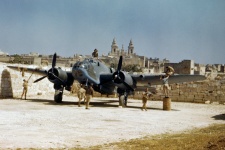 |
This beautiful photo of a Beaufort at Luqa, Malta shows the Azure Blue undersides and a traditional TSS topside camo. |
![]()
OTHER
Shadow Compensation (1938-40)
From The RAF employed a camouflage technique known as 'Shadow Compensation' for its biplanes, which involved lower wings being painted in lighter colors than the standard scheme. The intention for this was that the shadow of the upper wings would even out the colors. Shadow Compensation was used primarily for the Temperate Land Scheme as well as the Temperate Sea Schemes given that most British biplanes used in World War II were used early in the war by Fighter Command as well as by Coastal Command and the Fleet Air Arm. The term 'Shadow Compensation' is often referred to as 'Shadow Shading' although this was the term used initially (both by the RAF and USAAF) to describe the particular camouflage pattern as seen in the Temperate Land Scheme.
Shadow Compensation for the Temperate Land Scheme involved Light Earth and Light Green. Although Light Earth was used extensively in the early years of the North Africa campaign (before Middle Stone became more widely available), and is slightly lighter than Middle Stone and lacking its mustard tone. Light Green was a rare RAF color whose only main use was for shadow compensation. Light Green is closer to a medium green than Dark Green and a close approximation could be US Medium Green (FS 34102). Shadow Compensation for the Temperate Sea Scheme consisted of Light Slate Grey and Dark Sea Grey. Light Slate Grey is a green-grey, close to SAC Bomber Green (FS 34159) or German Field Gray (RAL 7009). Dark Sea Grey was used more widely in the post-war period. It is somewhat similar to the 'mixed grey' used as a replacement for Ocean Grey in the Day Fighter Scheme, being roughy similar in brightness but with much less blue.
One of the main differences between Shadow Shading on the two schemes is that biplanes using the Temperate Land Scheme frequently had sections of the fuselage also painted in the two lighter colors. For those aircraft with White/Night undersides, this effectively created a six-tone scheme. Shadow Compensation was abandoned by the RAF early in the war with lower wings being treated as upper surfaces from December 1940 onward although it presisted in the Fleet Air Arm until the end.
Paint guide:
- Dark Sea Grey: DSG is very well represented given its widespread post-war use. Despite its relative rarity in wartime service, Gunze offers a specific wartime variant (H75/C25) which makes the omission of more widely used colors like Ocean Grey and Dark Slate Grey all the more puzzling. Like its extra dark counterpart (EDSG), there are very little differences between the wartime and post-war shades and it can also be an effective substite for Mixed Grey given that it has less blue than Ocean Grey but is of similar brightness.
- Others: Mr. Paint is the only ranges to carry all other three colors matched while Xtracolor carries all but Light Green. FS approximations include FS 30257 (Light Earth), FS 34172 (Light Green), and FS 34159 (Light Slate Grey) which, unfortunately, are also relatively rare.
| Light Earth | Light Green | Light Slate Grey | Dark Sea Grey | |
| Schemes | ||||
| Temperate Land | Lower wing | Lower wing | ||
| Temperate Sea | Lower wing | Lower wing | ||
| Color matches | ||||
| Gunze Aqueous | - | - | - | H75 |
| Gunze Mr. Color | - | - | - | C25 |
| Humbrol | 119 | - | (31) | 164 |
| Model Master | - | - | - | 2059 |
| Revell | - | - | - | - |
| Tamiya | - | - | - | XF-54 |
| Vallejo Model Air | 71.291** | 71.403 | 71.406 | - |
| Vallejo Model Color | - | - | - | 70.991** |
| AKAN | - | - | 70018 | 70017 |
| AK Interactive | - | - | - | - |
| AK Real Color | - | - | - | RC296 |
| AMMO by Mig | - | - | - | - |
| Colourcoats | ACRN26 | ACRN25 | ACRN05 | ACRN03 |
| Hataka | - | - | - | HTK-_140 |
| Lifecolor | UA 081** | UA 002** | - | UA 108** |
| Mission Models | - | - | - | - |
| Mr. Paint | MRP-107 | MRP-109 | MRP-116 | MRP-113 |
| Xtracolor | X049 | - | X037 | X004 |
| Xtracrylix | - | - | XA1037 | XA1004 |
Lend-Lease schemes (1941-45)
The UK was the main recipient of US Lend-Lease aid, and the RAF received thousands of aircraft which saw action in all fronts. The most common are described below:
- Fighters: Although the RAF could rightfully brag about having superior fighters than the USAAF, US fighters helped plug much needed gaps throught the conflict. The most widely used US aircraft was the P-40, which was known as the Tomahawk (P-40B/C) or Kittyhawk (all later variants) and saw extensive service in North Africa. Smaller numbers of P-47s (Thunderbolt) and P-51s (Mustang) were also procured, with the former being notable for their SEAC service while the latter were used as interceptors (including V-1 hunters) over the British Isles thanks to their speed. All US fighters tended to be painted in US equivalent paints to their relevant RAF schemes of their theaters or roles, although many of those that were sent to the UK and shipped abroad (mainly P-40s) were eventually overpainted with RAF colors after transfer. A small number of Thunderbolts and Mustangs were seen in their natural metal finish in the final months of the war. Fighter-recon aircraft (mainly Mustangs) were also painted in the US equivalent to PRU Blue, a color that was also used as standard on USAAF photo-reconnaissance aircraft (which included many reverse Lend-Lease Spitfires and Mosquitoes).
- Bombers: Much more than fighters, the RAF made extensive use of US light and medium bombers during World War II, with the A-20 (Boston/Havoc), B-25 (Mitchell), and B-26 (Marauder) being provided in large numbers. Two other designs, the Martin Maryland and Baltimore were used exclusively by British and Commonwealth forces as well. However, hardly any US heavy bombers were used as they were seen as unsuitable for night bombing and carried considerably smaller bomb loads to the RAF's 'heavies'. Early UK deliveries were made in US equivalent paints to the RAF's day bomber schemes. Mediterranean aircraft were either factory painted in the desert scheme or repainted in the field. However, by 1943, UK-based Lend-Lease bombers retained their original US camouflage colors, these being Dark Olive Drab No. 41 and Neutral Gray No. 43 from the topside and undersides respectively with some aircraft using Medium Green No. 42 blotches as with their USAAF counterparts. It is possible that very late in the war, ANA paints were used these being Olive Drab ANA 613 over Sea Gray ANA 603 with Medium Green 612 blotches.
- Transports: Due to mutual agreement, the UK imported most of their transport aircraft during the war, notably the C-47 (Dakota) which became the workforce of both the RAF and the USAAF. Transports followed similar guidelines to bombers, using theater-specific paints and many of them later switching to OD 41/NG 43 (ANA 613/ANA 603).
- Coastal: Coastal Command was another major user of US designs, notably the PBY (Catalina) flying boat, as well as the B-17 (Fortress) and B-24 (Liberator), the latter being heavy bombers that proved far better as maritime patrol aircraft and sub-hunters than as traditional bombers. US equivalents to the Temperate Sea Scheme were used.
US equivalent paints initially followed DuPont standards intended to match RAF paints. Of the Temperate Land Scheme colors of Dark Earth (71-009) and Dark Green (71-013), the former was noticeably lighter although the latter was very close. They best match FS 30219 and FS 34096 respectively although FS 34079 has been suggested for Dark Green as well (it is very similar). Confusingly, a second variant of Dark Earth (71-035) came in use later and this was much darker, being closer to the RAF color and also fading less. It closely matches FS 30118. In contrast, Sky (71-021) has been an endless source of controversy. Of all the DuPont equivalents it is the one that is least similar to the original, being noticeably lighter and lacking the yellowish hue of Sky Type S. Its closest match is FS 35622 which happens to be known as a 'Duck Egg Blue'. In color photographs, however, it frequently ends up resembling different types of gray, often a light tan grey (closest to FS 36622) as well as a sky gray which could reflect attempts to match Sky Grey rather than Sky Type S. To what extent this reflects an actually different paint shades or simply different color characteristics of the photo is what drives the confusion: most color photos of 71-021 are in factory-fresh aircraft whereas most photos of Sky Type S are of aircraft in the field and thus dirtier. Furthermore, factory-fresh photos of Sky Type S are often of early Hurricanes and Spitfires which may have been painted Sky Blue, which in black and white appears lighter and would contrast more sharply with the topside colors just as the DuPont colors do. Regardless of what photos appear to show, the expert consensus is that 71-021 is indeed a pale gray-green and not a light gray.
As for the Desert Scheme, Middle Stone (71-069) was similar in brightness thus probably looking identical in black and white but lacked the mustard tone of its MAP counterpart. It is closest to FS 30266. When paired with the later Dark Earth (71-035) it would have had much greater contrast than the RAF originals or with 71-009. In contrast, Azure Blue (71-062) was very close to the RAF version aside from being a bit darker and has been matched with FS 35231.
Once the newer ANA colors were developed, US factories were ordered to use designated ANA equivalents instead of DuPont matches. In many cases, these varied significantly from their RAF colors. Although some colors like Dark Earth (71-035), Middle Stone, Sky, and Azure Blue received their own ANA successors, the colors used in the Day Fighter and Temperate Sea Scheme did not. Instead, both schemes used the same equivalents for their greens and grays, these being Olive Drab 613 (closest to FS 33077 though superseded by FS 34087) and Sea Grey ANA 603 (closest to FS 36118) respectively. While they were close enough to the TSS, they were far less of a match to the DFS: Olive Drab was too dark and too brown and Sea Grey was also too dark and lacked Ocean Grey's distinctive blue tint. Additonally, the US equivalent to Medium Sea Grey was Light Grey ANA 602. This is often matched to FS 36440 but it is believed that it was somewhat darker but still unsuitable as an equivalent to Medium Sea Grey and was said to have been discontinued shortly after introduced in favor of Dark Gull Gray ANA 621 which was of similar brightness although still somewhat warmer. As with USAAF aircraft, it is likely that stocks of Olive Drab No. 41 were used before switching to ANA 613 which leads to the possibility that only few late-builds ever used it if at all. Finally, Sky ANA 610 was much closer to the original Sky Type S than the earlier DuPont equivalent and virtually identical to the post-war FS 34424 that superseded it.
A comparison between US and RAF paints is provided below with the disclaimer that hex equivalents will never be fully accurate to an original paint chip.
| RAF | US | FS | RAF | US | FS | ||
| Dark Green (1) | Ocean Grey | ||||||
| 71-013 | 34083 | ANA 603 | 36118 | ||||
| Dark Earth (1) | Dark Green (2) | ||||||
| 71-009 | 30140 | ANA 613 | 33077 | ||||
| Dark Earth (2) | Medium Sea Grey (1) | ||||||
| 71-035 | 30118 | ANA 602 | 36440 | ||||
| Middle Stone | Medium Sea Grey (2) | ||||||
| 71-069 | 30266 | ANA 621 | 36231 | ||||
| Sky | Sky | ||||||
| 71-021 | 35622 | ANA 610 | 34424 | ||||
| Azure Blue | Dark Slate Grey | ||||||
| 71-062 | 35231 | ANA 613 | 33077 | ||||
| Extra Dark Sea Grey | |||||||
| ANA 603 | 36118 | ||||||
Paint guide: The following paint chart includes only the US equivalents to the Temperate Land (plus Sky) and Desert (plus Azure Blue) schemes as those were the only two to have been used extensively before the ANA equivalent colors were designated. DuPont numbers are in the topmost header row. It should be noted that hardly any paint ranges (Mr. Paint being the sole exception as well as Colourcoats for Sky) carry DuPont/ANA-specific RAF paints, with most merely including them in the labels for convenience. Rather than merely repeat the matches for RAF paints from previous sections, the paint chart takes the closest FS equivalents mentioned in the text in parenthesis under the assumption that modelers will want to make their Lend-Lease models look sufficiently different from home-produced RAF aircraft, the exception being Azure Blue which is virtually identical.
- Sky (71-021): Colourcoats is the only range to carry a specific US equivalent Sky (ACRN36) which has been matched to an original DuPont paint chip. The closest available equivalent to the DuPont shade is FS 35622 which is a pale blue-green known for its use by the Israeli Defence Force. It is frequently labeled 'Duck Egg Blue' which, ironically, is the same name that was colloqually given to Sky Type S in Air Ministry Orders. All matches to FS 35622 are taken as close equivalents in parenthesis. For a paint guide of the later Sky ANA 610, see the Lend-Lease section on the FAA page.
- Middle Stone (71-069 / ANA 615): The close equivalent is FS 30257 which is has only moderate availability, although Tamiya XF-59 (Desert Yellow) seems remarkably close. Beware of any ANA/RAF matches as they will likely be closer to the original and thus too mustard-like compared to the US version.
- Dark Earth (71-009): The close equivalent, FS 30219, is widely available and is included in parenthesis. It is usually labeled Sierra Tan and was a late addition to the ANA range (ANA 628).
- Dark Earth (71-035 / ANA 617): The close equivalent, FS 30118, is widely available and included in parenthesis. It is often labeled Field Drab. Mr. Paint includes a specific ANA 617 paint (MRP-145) in its range.
- Dark Green (71-013): The close equivalent, FS 34083, is relatively rare and so the similar and more widely available FS 34079 is included in parenthesis. Both FS colors are labeled forest greens, with the former being the air force and the latter the army versions. FS 34079 also has a late addition ANA predecessor (ANA 631).
Links:
- Curtis camouflage on A.V.G. Tomahawks
- Flickr photo album of AVG P-40, lots of colour too (Britmodeller)
- WW2 US Colours on British Aircraft (Britmodeller)
- ACRN36 - US Equivalent Sky (Britmodeller)
| ANA 609 | ANA 615 | ANA 617 | ||||
| 71-021 | 71-062 | 71-069 | 71-009 | 71-035 | 71-013 | |
| Sky | Azure Blue | Middle Stone | Dark Earth (1) | Dark Earth (2) | Dark Green | |
| Schemes | ||||||
| TLS | Lower | (Upper Camo) | (Upper Camo) | Upper Camo | ||
| Desert | Lower | Upper Camo | (Upper Camo) | (Upper Camo) | ||
| Color matches | ||||||
| Gunze Aqueous | (H314) | - | - | (H310) | - | (H309) |
| Gunze Mr. Color | (C314) | (C370) | - | (C310) | - | (C309) |
| Humbrol | - | (157) | - | (118) | - | (116) |
| Model Master | (1722) | 2048** | 2052** | (1742) | 2054** / (1702) | (1710) |
| Revell | - | - | - | - | - | - |
| Tamiya | - | - | (XF-59) (?) | - | - | - |
| Vallejo Model Air | (71.328) | 71.108** | (71.291) | (71.125) | 71.139** | (71.294) |
| Vallejo Model Color | - | 70.902** | (70.977) | (70.874) | (70.873) | (70.893) |
| AKAN | (72074) | (70004) | (6/82044) | (72003) | (6/82045) | (72002) |
| AK Interactive | (AK 2154) | (AK 2017) | - | (AK 2103) | - | (AK 2101) |
| AK Real Color | (RC241) | (RC291) | (RC030) | (RC225) | (RC085) | (RC027) |
| AMMO by Mig | - | - | - | (A.MIG-202) | - | (A.MIG-206) (?) |
| Colourcoats | ACRN36 | (ACRN34) | - | (ACUS18) | - | (ACUS20) |
| Hataka | (HTK-_092) | (HTK-_028) | - | (HTK-_012) | - | (HTK-_016) |
| Lifecolor | (UA 139) | (UA 098) | (UA 081) | (UA 015) | UA 092** | (UA 001) |
| Mission Models | MMP-080** | MMP-092** | - | (MMP-066) | - | (MMP-058) |
| Mr. Paint | (MRP-225) | MRP-143 | (MPR-368) | (MRP-103) | MRP-145 | (MRP-101) |
| Xtracolor | (X149) | (X026) | - | (X102) | (X101) | (X110) |
| Xtracrylix | - | (XA1026) | - | (XA1002) | - | (XA1110) |
Transports (1939-45)
Early in the war, the RAF did not specify specific paints for its transport aircraft and these were order to use whatever scheme was felt relevant for their operational requirements. As such, transports tended to use the 'default' schemes for their regions, such as Temperate Land Scheme (Dark Earth and Dark Green over Sky) and Day Fighter Scheme (Ocean Grey and Dark Green over Medium Sea Grey) for UK-based aircraft as well as the Desert Scheme (Middle Stone and Dark Earth) for aircraft based in the Mediterranean, in the latter case it was frequent for transports to retain Sky undersides rather than the more theater-relevant Azure Blue. There were considerable exceptions and so there is no hard rule to go by; the relevant scheme must be deduced from photographic evidence.
The RAF was an early adopter of the US-built Dakota (C-47) which soon became the main transport aircraft of both Allied powers, and this was partly the result of an agremeent between US and UK authorities for the UK aircraft industry to concentrate on combat aircraft where it had a comparative advantage. Around one-fifth of all C-47s produced in the US ended up in RAF hands. Like most Lend-Lease aircraft, these were initially provided in US equivalents to RAF paints or re-painted in theater which was common in North Africa and Italy. However, from 1943 onward the majority of UK-based Dakotas were left in their original Dark Olive Drab No. 41 over Neutral Grey No. 43 (later Olive Drab ANA 613 over Sea Grey ANA 603) colors as used by the USAAF. Blotches of Medium Green No. 42 (ANA 612) were also common.
A specific transport scheme was eventually adopted in 1944 (AP 2656A) which specified a topside camouflage equivalent to the Temperate Sea Scheme, that is, Dark Slate Grey and Extra Dark Sea Grey. Undersides were to be Azure Blue or, if required, Night. Towards the end of the war and in the immediate post-war period, many RAF transports were left in natural metal finish (NMF). Aircraft to which these schemes applied were mostly British-built aircraft, usually transport variants of older heavy bombers like the Stirling and Halifax or the sole late-war dedicated transport, the York. US-built transports largerly remined in their original colors throughout the war.
The RAF also made extensive use of gliders as part of airborne operations and these followed the same scheme as night bombers. From 1944 (AP 2656A) gliders were specified as Dark Earth and Dark Green over Special Night with high demarcations.
Paint guide: All RAF colors are described previously or in the USAAF page. Given the dominance of the Dakota in the RAF transport inventory, the original USAAF colors are provided below for convenience (US equivalent RAF colors are described in the Lend-Lease section)
| Azure Blue | Dark Slate Grey | Extra Dark Sea Grey | Aluminium | |
| Scheme | ||||
| Transport (Late) | Lower | Upper camo | Upper camo | |
| NMF | Overall | |||
| Paints | ||||
| Gunze Aqueous | - | - | H333 | (H8) |
| Gunze Mr. Color | C370 | - | C333 | (C8) |
| Humbrol | 157 (!) | 224 | 123 | 56 |
| Model Master | 2048 | 2056 | 2059 | 1781 |
| Revell | - | - | - | 99 |
| Tamiya | - | - | - | XF-16 |
| Vallejo Model Air | 71.108 | 71.309 | 71.110 | 71.062 |
| Vallejo Model Color | 70.902 | - | - | - |
| AKAN | 70004 | 70046 | 70019 | 76004 |
| AK Interactive | AK 2017 | - | - | - |
| AK Real Color | RC291 | RC294 | RC295 | RC020 |
| AMMO by Mig | - | - | - | A.MIG-194 |
| Colourcoats | ACRN34 | ACRN06 | ACRN02 | |
| Hataka | HTK-_028 | HTK-_202 | HTK-_140 | HTK-_078 |
| Lifecolor | UA 098** | - | - | LC-74 |
| Mission Models | MMP-092 | - | - | MMM-003 |
| Mr. Paint | MRP-119 | MRP-117 | MRP-114 | MRP-3 |
| Xtracolor | X026 | X025 | X005 | X142 |
| Xtracrylix | XA1026 | XA1025 | XA1005 | (XA1216) |
Royal Australian Air Force schemes (1941-45)
The Royal Australian Air Force (RAAF) had its own palette which, while roughly based on RAF colors, had slight variations to the originals. Additionally there was a small number of unique colors which are the subject of this section. RAAF aircraft followed a similar camouflage pattern as the RAF but with differnet colors. The topside camouflage was composed of Earth Brown K3/178 and Foliage Green K3/177. Earth Brown was more akin to a chocolate brown and slightly darker than RAF Dark Earth. It has been matched to FS 30099. Foliage Green was a deeper green than RAF Dark Grey, and would have certainly been better suited for the lush jungle canopies of the South Pacific. There is a debate on whether it more adequately matches US FS 34092 or FS 34096. The use of these colors would have resulted in RAAF topsides looking darker and warmer than their RAF counterparts. Undersides were painted Sky Blue K3/195. This would have been similar to its RAF equivalent although brighter, thus making it more appropriate for the clearer Pacific skies. Aircraft employed in night operations had their undersides painted Night K3/179 or Special Night K3/315. Many RAAF aircraft in the South Pacific (mainly fighters) featured prominent white tails like their USAAF counterparts. They also had white leading edges, possibly to distinguish from the yellow leading edges of Japanese fighters, and these typically extended across the whole wing.
From December 1943, RAAF aircraft dispenseed with the Earth Brown, leaving many aircraft with single topside color of Foliage Green. Undersides were painted Medium Sea Grey K3/183, similar to its RAF equivalent and also lighter than an earlier grey that was used as a pre-war underside (before Sky Blue became available). Many aircraft, particularly twin-engined ones like the Beaufighter and Mitchell, were painted in overall Foliage Green. From May 1944 it was further ordered that all RAAF combat aircraft be delivered in natural metal finish (NMF). Aircraft that had already been painted likely remained so.
Lend-Lease aircraft from the US were usually left in their original colors (Dark Olive Drab No. 41 over Neutral Gray No. 43 with optional Medium Green No. 42 blotches) with occasional modificatons such as repainting the underside Sky Blue in some early aircraft. Some early aircraft may have been painted in US equivalents (DuPont matches) of the Temperate Land scheme. Likewise, many British aircraft like Spitfires were left in their original RAF colors, either the Temperate Land, Temperate Sea, or Day Fighter schemes, or in their respective RAAF equivalents. It was common to see RAF schemes with some RAAF color modifications or touch ups and overall, it must be emphasized that there were no hard rules for RAAF aircraft overall. For example, one interesting and unique paint scheme were the 'Black Cats', a number of Catalinas that were painted black in order to conduct special night-time operations deep into Japanese-controlled waters.
The RAAF palette largely applied to aircraft that served in the Pacific theater, usually under US command. Many RAAF squadrons were attacked to the RAF in Europe and the Mediterranean and in these cases, followed RAF conventions relative to their theater and role. A similar logic applied to the Royal New Zealand Air Force (RNZAAF) which in the Pacific largely used US Navy colors or equivalents from its own palette.
Paint guide: Only Colourcoats and Lifecolor make RAAF-specific paints. Of the four main colors, the underside Sky Blue and Medium Sea Grey are closest to their RAF equivalents and should be an acceptable substitute. Earth Brown and Foliage Green are trickier and, barring specific paints, can be matched to their closest FS equivalents, FS 30099 or FS 34092/34096. Because the latter are almost universally available, only direct matches are provided below. FS 30099 is rarer, but available from Vallejo, AK Real Colors, and Hataka. Tamiya's Flat Earth (XF-52) is probably the closest generic equivalent, and certainly closer to the RAAF color than RAF Dark Earth. Colourcoats also has a small range of RNZAAF colors.
Links:
- RAAF Foliage Green: A Brief Discussion (Gary Byk and Peter Malone)
- RAAF Markings and Codes (WW2Aircraft.net)
| K3/195 | K3/183 | K3/178 | K3/177 | ||
| RAAF Sky Blue | RAAF Medium Sea Grey | RAAF Earth Brown | RAAF Foliage Green | Aluminium | |
| Schemes | |||||
| RAAF (1941-42) | Lower | Upper camo | Upper camo | ||
| RAAF (1943-44) | Lower | Upper | |||
| RAAF (1944-45) | Overall | ||||
| Color matches | |||||
| Gunze Aqueous | - | (H335) | - | - | (H8) |
| Gunze Mr. Color | - | (C335) / (C363) | - | - | (C8) |
| Humbrol | (23) | (165) | - | - | 56 |
| Model Master | - | (2058) | - | - | 1781 |
| Revell | - | - | - | - | 99 |
| Tamiya | - | (XF-83) | (XF-52) (?) | - | XF-16 |
| Vallejo Model Air | (71.404) | (71.307) | - | - | 71.062 |
| Vallejo Model Color | - | (70.870) | (70.872) | - | - |
| AKAN | - | (70016) | - | - | 76004 |
| AK Interactive | - | (AK 2013) | - | - | - |
| AK Real Color | - | (RC289) | (RC029) | - | RC020 |
| AMMO by Mig | - | (A.MIG-246) | - | - | A.MIG-194 |
| Colourcoats | ACOZ01 | ACOZ12 | ACOZ03 | ACOZ02 | - |
| Hataka | - | (HTK-_034) | (HTK-_256) | - | HTK-_078 |
| Lifecolor | UA 515 | UA 515 | UA 513 | UA 514 | LC-74 |
| Mission Models | - | (MMP-094) | MMM-003 | ||
| Mr. Paint | - | (MRP-112) | MRP-F043 | MRP-F034 | MRP-3 |
| Xtracolor | - | (X003) | X142 | ||
| Xtracrylix | - | (XA1003) | (XA1216) | ||
Interiors (1939-45)
Compared to their US counterparts, RAF aircraft had a refreshing consistency in terms of cockpit and interior colors. The basic cockpit color used universally across all RAF combat aircraft was Grey Green, which as its name implies was a slightly lightened and dulled out green. Aside from black instrument panels, this color was only interrupted by the color of certain aircraft seats (notably the Spitfire) which was a leather-like red-brown which I presume was used to blend better with the actual leather cushions of the backrest. Grey Green was also used as an interior color, with some aircraft showing evidence of this in the wheel wells. From mid-1942, some aircraft like the Typhoon and Tempest (and later Meteor) began carrying Night cockpits. Late Spitfires like the Mk XIV retained Grey Green throughout the war, not swtiching to Night until later in the post-war period.
For the most part, however, there was no standard interior color although each aircraft design tended to follow similar practice. For example, Spitfires almost always had wheel wells in the same color as the fuselage underside color. Hawker aircraft (Hurricane, Typhoon, and Tempest) frequently kept their wheel wells in natural metal. Twin-engined aircraft like Beaufighters and Mosquitoes often had parts of the wheel well in metal as well as Grey Green, the latter being the color of bomb bays if available. Four-engined bombers had them in metal and black, like the undersides, with bomb bays also in black. Landing gear as well as wheel caps were usually left either in natural metal or the fuselage underside color. It appears that a larger share of aircraft using the early Temperate Land Scheme aircraft, Desert Scheme aircraft, and night bombers used underside colors for their wheel wells.
Lend-Lease aircraft retained their US cockpit and interiors colors which were highly manufacturer-specific. The USAAF page gives further detail.
Paint guide: Grey Green is widely available and not particularly difficult to get wrong, especially considering how much cockpit colors can vary due to lighting. It is often approximated to FS 34226. A standard leather red-brown like Tamiya XF-64 or an equivalent to German RAL 8012 is good enough for Spitfire seats.
| Grey Green | Night | Aluminium | |
| Scheme | |||
| General | Cockpit / (Interiors) | (Interiors) | |
| Late | Cockpit / (Interiors) | (Interiors) | |
| Paints | |||
| Gunze Aqueous | - | (H77) | (H8) |
| Gunze Mr. Color | C364 | C125 | (C8) |
| Humbrol | 78 | - | 56 |
| Model Master | 2062 | - | 1781 |
| Revell | - | - | 99 |
| Tamiya | - | (XF-85) | XF-16 |
| Vallejo Model Air | 71.126** | (71.315) | 71.062 |
| Vallejo Model Color | - | (70.862) | - |
| AKAN | 70007 | (79043) | 76004 |
| AK Interactive | AK 2018 | AK 2066 | - |
| AK Real Color | RC293 | (RC022) | RC020 |
| AMMO by Mig | A.MIG-219** | (A.MIG-033) | A.MIG-194 |
| Colourcoats | ACRN28 | (ACRN17) | - |
| Hataka | HTK-_025 | - | HTK-_078 |
| Lifecolor | UA 551** | - | LC-74 |
| Mission Models | MMP-079 | MMP-108 | MMM-003 |
| Mr. Paint | MRP-111 | (MRP-255) | MRP-3 |
| Xtracolor | X010 | X012 | X142 |
| Xtracrylix | XA1010 | XA1012 | (XA1216) |
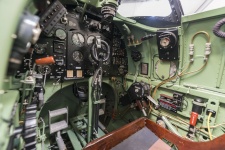 |
A Spitfire Mk IX cockpit from the Biggin Hill Heritage Hangar (a restoration facility) showing the ubiquitous interior Gray Green color and the red-brown seat. |
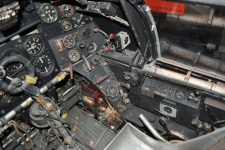 |
Most late Hawker aircraft like this Typhoon Mk Ib at the Imperial War Museum in Duxford had Night cockpits. In cockpits, Night easily contrasted with the darker basic black of the instrument panel. (Photo credit: Richard Crockett via Flickr) |
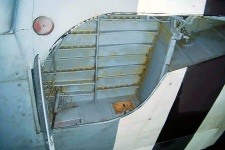 |
The wheel wells on this Typhoon Mk Ib at the RAF Museum in Hendon are painted Medium Sea Grey, just like the underside. Although not shown in this photo, this aircraft also has MSG landing gear and wheel caps (walkaround link here). |
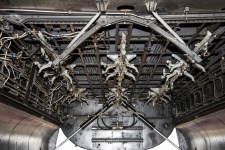 |
The massive bomb bay in this Canadian-built Lancaster B.X (equivalent to the British-built B.III) is painted in Night. Also note the differences with the black struts. |
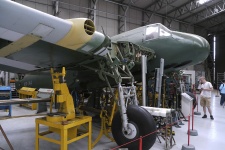 |
This Beaufighter under restoration at the Imperial War Museum in Duxford shows the combination of Grey Green and natural metal parts that was common in the larger wheel wells of twin-engined aircraft. |
Color Tables
| BS 1948 | BS 1943/44 | |||
| No 1 | Sky Blue | BS 101 | No 1 | |
| No 2 | Turquoise Blue | BS 102 | No 2 | |
| No 3 | Peacock Blue | BS 103 | No 3 | |
| No 4 | Azure Blue | BS 104 | No 4 | |
| No 5 | Oxford Blue | BS 105 | - | |
| No 6 | Royal Blue | BS 106 | No 6 | |
| No 7 | Dark Blue | BS 107** | - | |
| No 10 | Light Brown | BS 410 | - | |
| No 11 | Middle Brown | BS 411 | No 11 | |
| No 12 | Dark Brown | BS 412 | No 12 | |
| No 13 | Nut Brown | BS 413 | - | |
| No 14 | Golden Brown | BS 414 | - | |
| No 16 | Eau de Nil | BS 216 | - | |
| No 17 | Sea Green | BS 217 | - | |
| No 18 | Grass Green | BS 218 | - | |
| No 19 | Sage Green | BS 219 | - | |
| No 20 | Olive Green | BS 220 | - | |
| No 21 | Brilliant Green | BS 221 | No 21 | |
| No 22 | Light Bronze Green | BS 222 | - | |
| No 23 | Middle Bronze Green | BS 223 | - | |
| No 24 | Deep Bronze Green | BS 224 | - | |
| No 25 | Light Brunswick Green | BS 225 | No 25 | |
| No 26 | Middle Brunswick Green | BS 226 | No 26 | |
| No 27 | Deep Brunswick Green | BS 227 | - | |
| No 28 | Silver Grey | BS 628 | No 28 | |
| No 29 | Quaker Grey | BS 629** | No 29 | |
| No 30 | French Grey | BS 630 | ||
| No 31 | Light Battleship Grey | BS 631** | No 31 | |
| No 32 | Dark Battleship Grey | BS 632** | No 32 | |
| No 33* | RAF Blue Grey | BS 633 | - | |
| No 34 | Slate | BS 634 | - | |
| No 35 | Lead | BS 635 | - | |
| No 37 | Signal Red | BS 537 | No 37 | |
| No 38 | Post Office Red | BS 538** | - | |
| No 40 | Crimson | BS 540 | - | |
| No 41 | Maroon | BS 541 | - | |
| No 43 | Salmon Pink | BS 447 | No 43 | |
| No 44 | Terra Cotta | BS 444 | No 44 | |
| No 45 | Venetian Red | BS 445 | - | |
| No 46 | Red Oxide | BS 446 | No 46 | |
| No 47 | Light Indian Red | - | - | |
| No 48 | Deep Indian Red | BS 448 | - | |
| No 49 | Light Purple Brown | BS 449 | - | |
| No 50 | Deep Purple Brown | - | - | |
| No 51 | Chocolate | - | No 51 | |
| No 52 | Pale Cream | BS 352 | No 52 | |
| No 53 | Deep Cream | BS 353 | No 53 | |
| No 54 | Primrose | BS 354 | - | |
| No 55 | Lemon | BS 355 | No 55 | |
| No 56 | Golden Yellow | BS 356 | No 56 | |
| No 57 | Orange | BS 557** | No 57 | |
| No 58 | Light Buff | BS 358 | - | |
| No 59 | Middle Buff | BS 359 | No 59 | |
| No 60 | Deep Buff | BS 360 | - | |
| No 61 | Light Stone | BS 361 | No 61 | |
| No 62 | Middle Stone | BS 362 | - | |
| No 63 | Dark Stone | - | - | |
| No 64 | Portland Stone | BS 364 | No 64 | |
| No 67* | Traffic Green | BS 267** | - | |
| No 68* | Traffic Yellow | BS 368 | - | |
| No 70* | Traffic Red | BS 570 | - | |
| No 71* | Middle Graphite | BS 671 | - | |
| No 72* | Dark Graphite | - | - | |
| No 73* | Gulf Red | BS 473 | - | |
* Colors added to palette after 1931
** Colors have had their names changed after 1948
| BS 1948 | BS 1931 | DuPont | FED-STD* | Munsell** | ||
| Light Earth | - | - | 71-048 | FS 30257 | ? | |
| Dark Earth | BS 350 | - | 71-035 | FS 30118 | ? | |
| Light Green | - | - | 71-047 | FS 34172 | ? | |
| Dark Green | BS 241 | - | 71-013 | FS 34083 | 10Y 2.9/1.5 | |
| Extra Dark Sea Green | - | - | 71-067 | FS 34092 | ? | |
| Grey Green | BS 238 | - | 71-036 | FS 34226 | ? | |
| Medium Sea Grey | BS 637 | - | FS 36270 | ? | ||
| Dark Sea Grey | BS 638 | - | - | FS 36173 | ? | |
| Extra Dark Sea Grey | BS 640 | - | 71-19324 | FS 36118 | ? | |
| Ocean Grey | - | - | 71-068 | FS 36152 | 7B 4.5/1 | |
| Light Slate Grey | BS 639 | - | - | FS 34159 | ? | |
| Dark Slate Grey | BS 634 | - | 71-19323 | FS 34096 | 0.5GY 3.7/1 | |
| Sky Grey | - | - | - | FS 36463 | ? | |
| Sky | BS 210 | - | 71-021 | FS 34504 | ? | |
| Deep Sky | - | - | 71-052 | FS 35056 | ? | |
| Sky Blue | BS 101 | No 1 | 71-061 | FS 35550 | ? | |
| Azure Blue | BS 104 | No 4 | 71-062 | FS 35231 | 4.1PB 6.2/6.0 | |
| Light Mediterranean Blue | - | - | 71-063 | FS 35117 | 2.4PB 4.4/4.6 | |
| Dark Mediterranean Blue | - | - | 71-064 | FS 35109 | ? | |
| PRU Blue | BS 636 | - | 71-066 | FS 35164 | 5.3B 3.9/3 | |
| Middle Stone | BS 362 | No 62 | 71-069 | FS 30266 | ? | |
| Night | BS 642 | - | 71-006 | FS 37038 | ? | |
| Yellow | BS 356 | No 56 | 71-010 | FS 33538 | ? | |
| Red | - | - | - | FS 31105 | ? | |
| Blue | BS 110 | - | - | FS 35056 | ? | |
| Aluminum | - | - | - | - | ? | |
| Matt (Dull) Red | - | - | 71-007 | - | ? | |
| Matt (Dull) Blue | - | - | 71-012 | - | ? | |
| Semi Matt Black | - | - | - | - | ? | |
* Federal Standard numbers are approximate
** Munsell values quoted from Nick Millmann via Britmodeller. Hex values adapted from color plate in Tanner (1976).
| BS 1948 | FED-STD* | |||
| K3/169 | Bright Red | BS 538 | FS 31105 | |
| K3/170 | Identification White | - | FS 37875 | |
| K3/177 | Foliage Green | - | FS 34092 | |
| K3/178 | Earth Brown | - | FS 30099 | |
| K3/179 | Night | BS 642 | FS 37038 | |
| K3/183 | Medium Sea Grey | BS 637 | FS 36270 | |
| K3/185 | Yellow | BS 356 | FS 33538 | |
| K3/187 | Extra Dark Sea Grey | BS 640 | FS 36118 | |
| K3/188 | Dark Sea Grey | BS 638 | FS 36173 | |
| K3/189 | Dark Slate Grey | - | FS 34096 | |
| K3/190 | Light Slate Grey | BS 639 | FS 34159 | |
| K3/193 | Grey Green | BS 238 | FS 34226 | |
| K3/195 | Sky Blue | BS 101 | FS 35550 | |
| K3/197 | Dull Blue | BS 110 | FS 35056 | |
| K3/209 | Dark Earth | BS 350 | FS 30118 | |
| K3/216 | Dark Green | BS 241 | FS 34079 | |
| K3/223 | Light Earth | - | FS 30257 | |
| K3/225 | Light Green | - | FS 34172 | |
| K3/315 | Special Night | BS 642 | FS 37038 | |
| K3/316 | Azure Blue | BS 104 | FS 35231 | |
| K3/318 | Dark Ocean Blue | - | FS 35042 | |
* Federal Standard numbers are approximate
